Hong Kong Tourism and Shopping Experiences
VerifiedAdded on 2020/02/24
|19
|4419
|45
AI Summary
This assignment delves into the complex relationship between shopping and tourism in Hong Kong. Students are tasked with analyzing various factors influencing tourist shopping experiences, including resident perceptions, the role of place marketing, and the impact of economic crises on shopping tourism. The analysis should consider both positive and negative aspects, exploring challenges faced by the industry like dwindling mainland visitor numbers due to political tensions. Students will utilize a range of academic sources to build a comprehensive understanding of this dynamic topic.
Contribute Materials
Your contribution can guide someone’s learning journey. Share your
documents today.
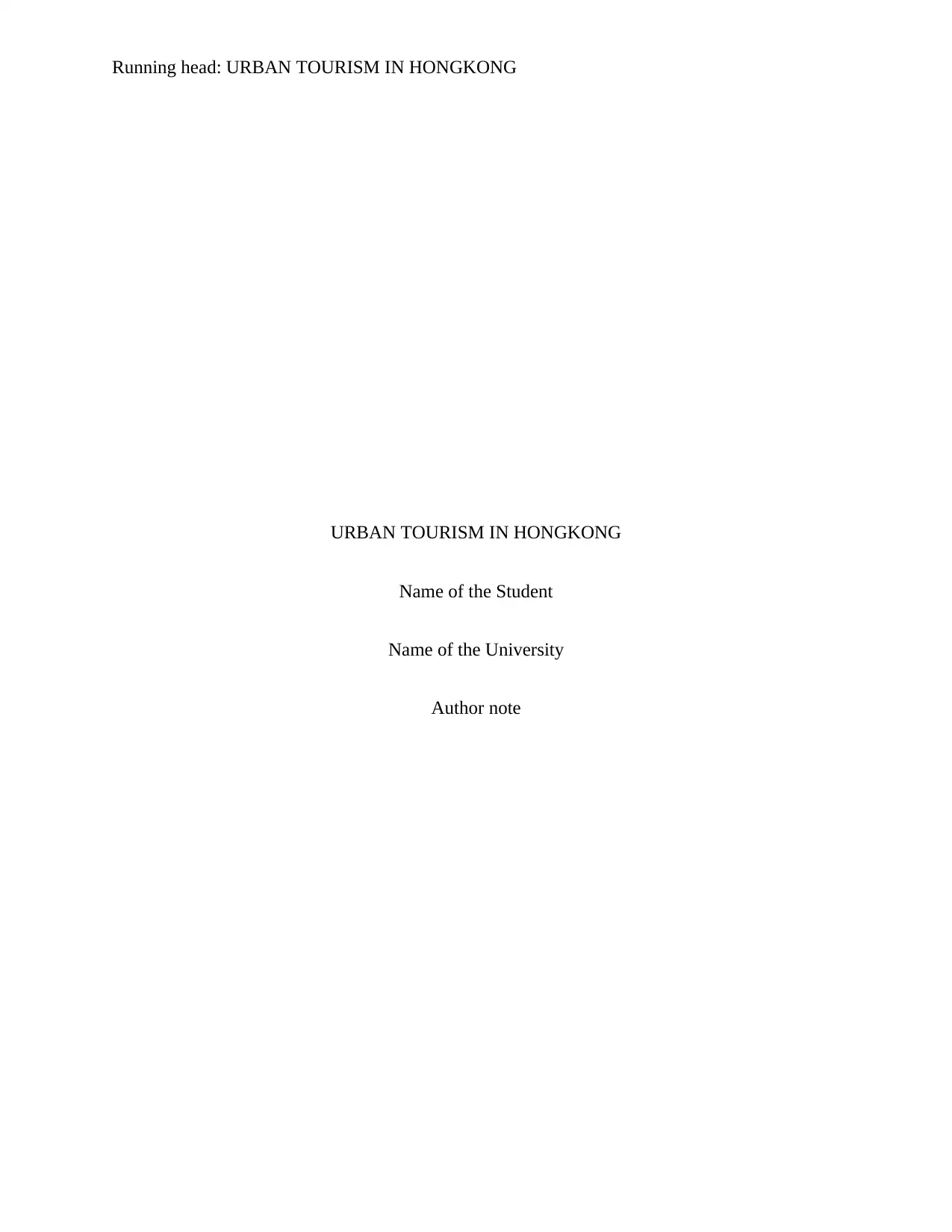
Running head: URBAN TOURISM IN HONGKONG
URBAN TOURISM IN HONGKONG
Name of the Student
Name of the University
Author note
URBAN TOURISM IN HONGKONG
Name of the Student
Name of the University
Author note
Secure Best Marks with AI Grader
Need help grading? Try our AI Grader for instant feedback on your assignments.
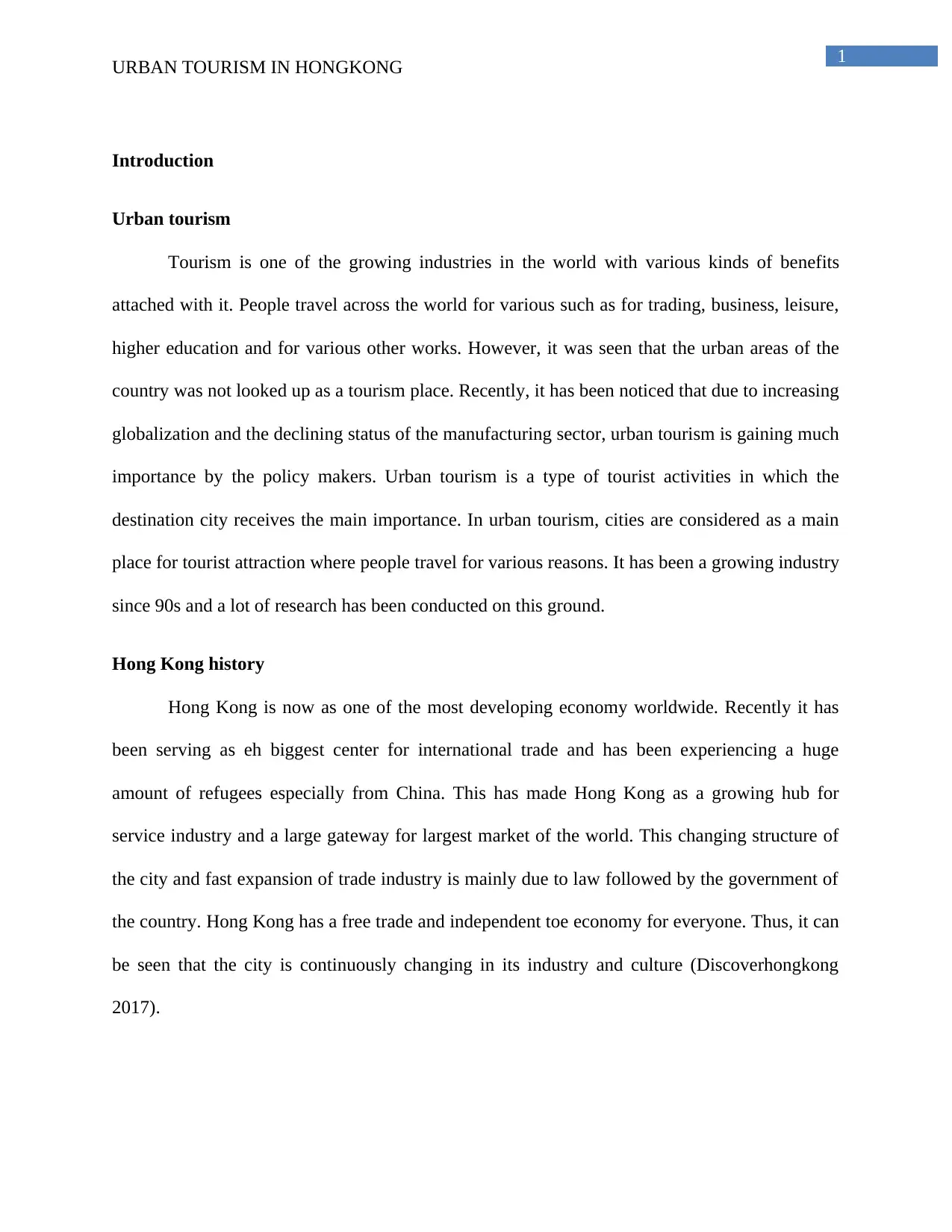
1
URBAN TOURISM IN HONGKONG
Introduction
Urban tourism
Tourism is one of the growing industries in the world with various kinds of benefits
attached with it. People travel across the world for various such as for trading, business, leisure,
higher education and for various other works. However, it was seen that the urban areas of the
country was not looked up as a tourism place. Recently, it has been noticed that due to increasing
globalization and the declining status of the manufacturing sector, urban tourism is gaining much
importance by the policy makers. Urban tourism is a type of tourist activities in which the
destination city receives the main importance. In urban tourism, cities are considered as a main
place for tourist attraction where people travel for various reasons. It has been a growing industry
since 90s and a lot of research has been conducted on this ground.
Hong Kong history
Hong Kong is now as one of the most developing economy worldwide. Recently it has
been serving as eh biggest center for international trade and has been experiencing a huge
amount of refugees especially from China. This has made Hong Kong as a growing hub for
service industry and a large gateway for largest market of the world. This changing structure of
the city and fast expansion of trade industry is mainly due to law followed by the government of
the country. Hong Kong has a free trade and independent toe economy for everyone. Thus, it can
be seen that the city is continuously changing in its industry and culture (Discoverhongkong
2017).
URBAN TOURISM IN HONGKONG
Introduction
Urban tourism
Tourism is one of the growing industries in the world with various kinds of benefits
attached with it. People travel across the world for various such as for trading, business, leisure,
higher education and for various other works. However, it was seen that the urban areas of the
country was not looked up as a tourism place. Recently, it has been noticed that due to increasing
globalization and the declining status of the manufacturing sector, urban tourism is gaining much
importance by the policy makers. Urban tourism is a type of tourist activities in which the
destination city receives the main importance. In urban tourism, cities are considered as a main
place for tourist attraction where people travel for various reasons. It has been a growing industry
since 90s and a lot of research has been conducted on this ground.
Hong Kong history
Hong Kong is now as one of the most developing economy worldwide. Recently it has
been serving as eh biggest center for international trade and has been experiencing a huge
amount of refugees especially from China. This has made Hong Kong as a growing hub for
service industry and a large gateway for largest market of the world. This changing structure of
the city and fast expansion of trade industry is mainly due to law followed by the government of
the country. Hong Kong has a free trade and independent toe economy for everyone. Thus, it can
be seen that the city is continuously changing in its industry and culture (Discoverhongkong
2017).
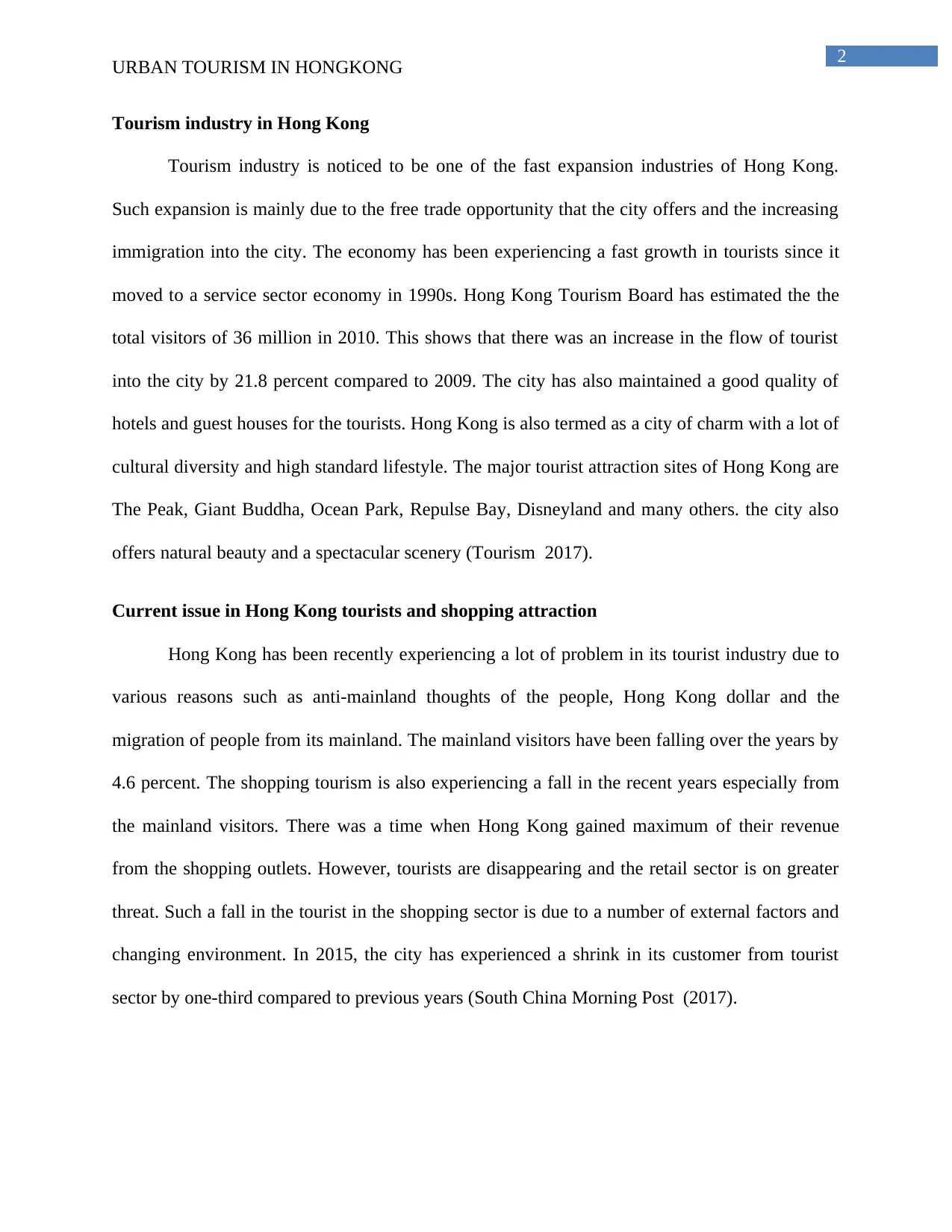
2
URBAN TOURISM IN HONGKONG
Tourism industry in Hong Kong
Tourism industry is noticed to be one of the fast expansion industries of Hong Kong.
Such expansion is mainly due to the free trade opportunity that the city offers and the increasing
immigration into the city. The economy has been experiencing a fast growth in tourists since it
moved to a service sector economy in 1990s. Hong Kong Tourism Board has estimated the the
total visitors of 36 million in 2010. This shows that there was an increase in the flow of tourist
into the city by 21.8 percent compared to 2009. The city has also maintained a good quality of
hotels and guest houses for the tourists. Hong Kong is also termed as a city of charm with a lot of
cultural diversity and high standard lifestyle. The major tourist attraction sites of Hong Kong are
The Peak, Giant Buddha, Ocean Park, Repulse Bay, Disneyland and many others. the city also
offers natural beauty and a spectacular scenery (Tourism 2017).
Current issue in Hong Kong tourists and shopping attraction
Hong Kong has been recently experiencing a lot of problem in its tourist industry due to
various reasons such as anti-mainland thoughts of the people, Hong Kong dollar and the
migration of people from its mainland. The mainland visitors have been falling over the years by
4.6 percent. The shopping tourism is also experiencing a fall in the recent years especially from
the mainland visitors. There was a time when Hong Kong gained maximum of their revenue
from the shopping outlets. However, tourists are disappearing and the retail sector is on greater
threat. Such a fall in the tourist in the shopping sector is due to a number of external factors and
changing environment. In 2015, the city has experienced a shrink in its customer from tourist
sector by one-third compared to previous years (South China Morning Post (2017).
URBAN TOURISM IN HONGKONG
Tourism industry in Hong Kong
Tourism industry is noticed to be one of the fast expansion industries of Hong Kong.
Such expansion is mainly due to the free trade opportunity that the city offers and the increasing
immigration into the city. The economy has been experiencing a fast growth in tourists since it
moved to a service sector economy in 1990s. Hong Kong Tourism Board has estimated the the
total visitors of 36 million in 2010. This shows that there was an increase in the flow of tourist
into the city by 21.8 percent compared to 2009. The city has also maintained a good quality of
hotels and guest houses for the tourists. Hong Kong is also termed as a city of charm with a lot of
cultural diversity and high standard lifestyle. The major tourist attraction sites of Hong Kong are
The Peak, Giant Buddha, Ocean Park, Repulse Bay, Disneyland and many others. the city also
offers natural beauty and a spectacular scenery (Tourism 2017).
Current issue in Hong Kong tourists and shopping attraction
Hong Kong has been recently experiencing a lot of problem in its tourist industry due to
various reasons such as anti-mainland thoughts of the people, Hong Kong dollar and the
migration of people from its mainland. The mainland visitors have been falling over the years by
4.6 percent. The shopping tourism is also experiencing a fall in the recent years especially from
the mainland visitors. There was a time when Hong Kong gained maximum of their revenue
from the shopping outlets. However, tourists are disappearing and the retail sector is on greater
threat. Such a fall in the tourist in the shopping sector is due to a number of external factors and
changing environment. In 2015, the city has experienced a shrink in its customer from tourist
sector by one-third compared to previous years (South China Morning Post (2017).
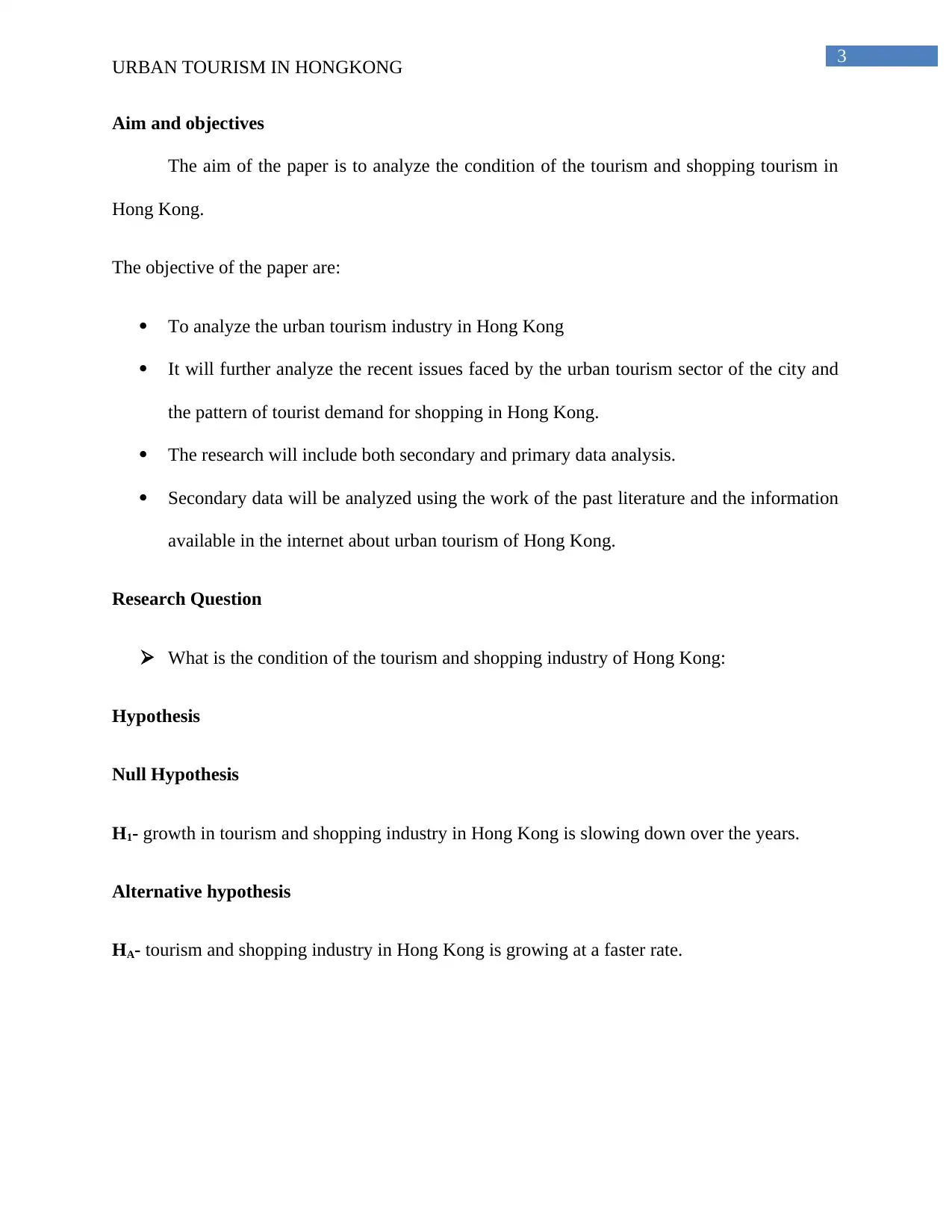
3
URBAN TOURISM IN HONGKONG
Aim and objectives
The aim of the paper is to analyze the condition of the tourism and shopping tourism in
Hong Kong.
The objective of the paper are:
To analyze the urban tourism industry in Hong Kong
It will further analyze the recent issues faced by the urban tourism sector of the city and
the pattern of tourist demand for shopping in Hong Kong.
The research will include both secondary and primary data analysis.
Secondary data will be analyzed using the work of the past literature and the information
available in the internet about urban tourism of Hong Kong.
Research Question
What is the condition of the tourism and shopping industry of Hong Kong:
Hypothesis
Null Hypothesis
H1- growth in tourism and shopping industry in Hong Kong is slowing down over the years.
Alternative hypothesis
HA- tourism and shopping industry in Hong Kong is growing at a faster rate.
URBAN TOURISM IN HONGKONG
Aim and objectives
The aim of the paper is to analyze the condition of the tourism and shopping tourism in
Hong Kong.
The objective of the paper are:
To analyze the urban tourism industry in Hong Kong
It will further analyze the recent issues faced by the urban tourism sector of the city and
the pattern of tourist demand for shopping in Hong Kong.
The research will include both secondary and primary data analysis.
Secondary data will be analyzed using the work of the past literature and the information
available in the internet about urban tourism of Hong Kong.
Research Question
What is the condition of the tourism and shopping industry of Hong Kong:
Hypothesis
Null Hypothesis
H1- growth in tourism and shopping industry in Hong Kong is slowing down over the years.
Alternative hypothesis
HA- tourism and shopping industry in Hong Kong is growing at a faster rate.
Secure Best Marks with AI Grader
Need help grading? Try our AI Grader for instant feedback on your assignments.
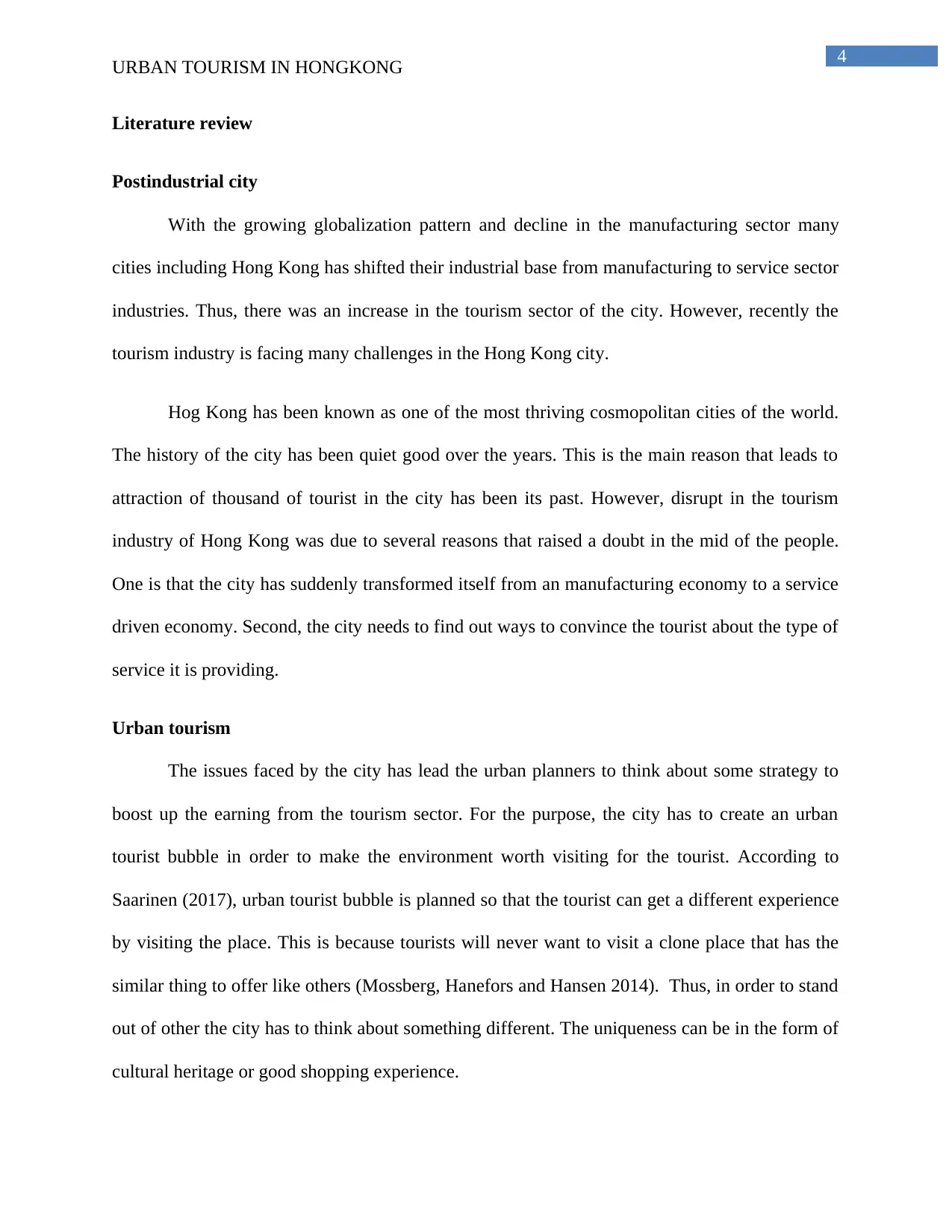
4
URBAN TOURISM IN HONGKONG
Literature review
Postindustrial city
With the growing globalization pattern and decline in the manufacturing sector many
cities including Hong Kong has shifted their industrial base from manufacturing to service sector
industries. Thus, there was an increase in the tourism sector of the city. However, recently the
tourism industry is facing many challenges in the Hong Kong city.
Hog Kong has been known as one of the most thriving cosmopolitan cities of the world.
The history of the city has been quiet good over the years. This is the main reason that leads to
attraction of thousand of tourist in the city has been its past. However, disrupt in the tourism
industry of Hong Kong was due to several reasons that raised a doubt in the mid of the people.
One is that the city has suddenly transformed itself from an manufacturing economy to a service
driven economy. Second, the city needs to find out ways to convince the tourist about the type of
service it is providing.
Urban tourism
The issues faced by the city has lead the urban planners to think about some strategy to
boost up the earning from the tourism sector. For the purpose, the city has to create an urban
tourist bubble in order to make the environment worth visiting for the tourist. According to
Saarinen (2017), urban tourist bubble is planned so that the tourist can get a different experience
by visiting the place. This is because tourists will never want to visit a clone place that has the
similar thing to offer like others (Mossberg, Hanefors and Hansen 2014). Thus, in order to stand
out of other the city has to think about something different. The uniqueness can be in the form of
cultural heritage or good shopping experience.
URBAN TOURISM IN HONGKONG
Literature review
Postindustrial city
With the growing globalization pattern and decline in the manufacturing sector many
cities including Hong Kong has shifted their industrial base from manufacturing to service sector
industries. Thus, there was an increase in the tourism sector of the city. However, recently the
tourism industry is facing many challenges in the Hong Kong city.
Hog Kong has been known as one of the most thriving cosmopolitan cities of the world.
The history of the city has been quiet good over the years. This is the main reason that leads to
attraction of thousand of tourist in the city has been its past. However, disrupt in the tourism
industry of Hong Kong was due to several reasons that raised a doubt in the mid of the people.
One is that the city has suddenly transformed itself from an manufacturing economy to a service
driven economy. Second, the city needs to find out ways to convince the tourist about the type of
service it is providing.
Urban tourism
The issues faced by the city has lead the urban planners to think about some strategy to
boost up the earning from the tourism sector. For the purpose, the city has to create an urban
tourist bubble in order to make the environment worth visiting for the tourist. According to
Saarinen (2017), urban tourist bubble is planned so that the tourist can get a different experience
by visiting the place. This is because tourists will never want to visit a clone place that has the
similar thing to offer like others (Mossberg, Hanefors and Hansen 2014). Thus, in order to stand
out of other the city has to think about something different. The uniqueness can be in the form of
cultural heritage or good shopping experience.
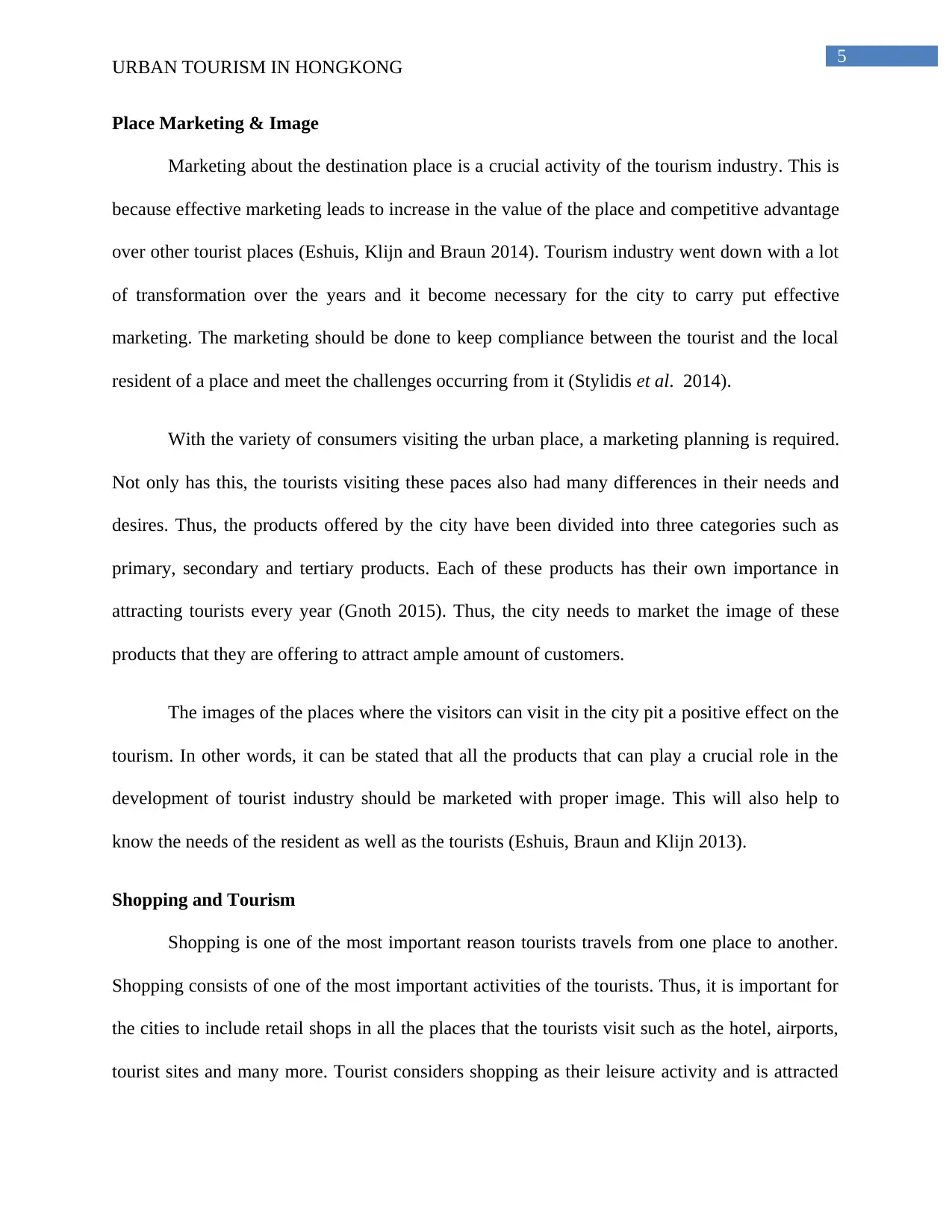
5
URBAN TOURISM IN HONGKONG
Place Marketing & Image
Marketing about the destination place is a crucial activity of the tourism industry. This is
because effective marketing leads to increase in the value of the place and competitive advantage
over other tourist places (Eshuis, Klijn and Braun 2014). Tourism industry went down with a lot
of transformation over the years and it become necessary for the city to carry put effective
marketing. The marketing should be done to keep compliance between the tourist and the local
resident of a place and meet the challenges occurring from it (Stylidis et al. 2014).
With the variety of consumers visiting the urban place, a marketing planning is required.
Not only has this, the tourists visiting these paces also had many differences in their needs and
desires. Thus, the products offered by the city have been divided into three categories such as
primary, secondary and tertiary products. Each of these products has their own importance in
attracting tourists every year (Gnoth 2015). Thus, the city needs to market the image of these
products that they are offering to attract ample amount of customers.
The images of the places where the visitors can visit in the city pit a positive effect on the
tourism. In other words, it can be stated that all the products that can play a crucial role in the
development of tourist industry should be marketed with proper image. This will also help to
know the needs of the resident as well as the tourists (Eshuis, Braun and Klijn 2013).
Shopping and Tourism
Shopping is one of the most important reason tourists travels from one place to another.
Shopping consists of one of the most important activities of the tourists. Thus, it is important for
the cities to include retail shops in all the places that the tourists visit such as the hotel, airports,
tourist sites and many more. Tourist considers shopping as their leisure activity and is attracted
URBAN TOURISM IN HONGKONG
Place Marketing & Image
Marketing about the destination place is a crucial activity of the tourism industry. This is
because effective marketing leads to increase in the value of the place and competitive advantage
over other tourist places (Eshuis, Klijn and Braun 2014). Tourism industry went down with a lot
of transformation over the years and it become necessary for the city to carry put effective
marketing. The marketing should be done to keep compliance between the tourist and the local
resident of a place and meet the challenges occurring from it (Stylidis et al. 2014).
With the variety of consumers visiting the urban place, a marketing planning is required.
Not only has this, the tourists visiting these paces also had many differences in their needs and
desires. Thus, the products offered by the city have been divided into three categories such as
primary, secondary and tertiary products. Each of these products has their own importance in
attracting tourists every year (Gnoth 2015). Thus, the city needs to market the image of these
products that they are offering to attract ample amount of customers.
The images of the places where the visitors can visit in the city pit a positive effect on the
tourism. In other words, it can be stated that all the products that can play a crucial role in the
development of tourist industry should be marketed with proper image. This will also help to
know the needs of the resident as well as the tourists (Eshuis, Braun and Klijn 2013).
Shopping and Tourism
Shopping is one of the most important reason tourists travels from one place to another.
Shopping consists of one of the most important activities of the tourists. Thus, it is important for
the cities to include retail shops in all the places that the tourists visit such as the hotel, airports,
tourist sites and many more. Tourist considers shopping as their leisure activity and is attracted
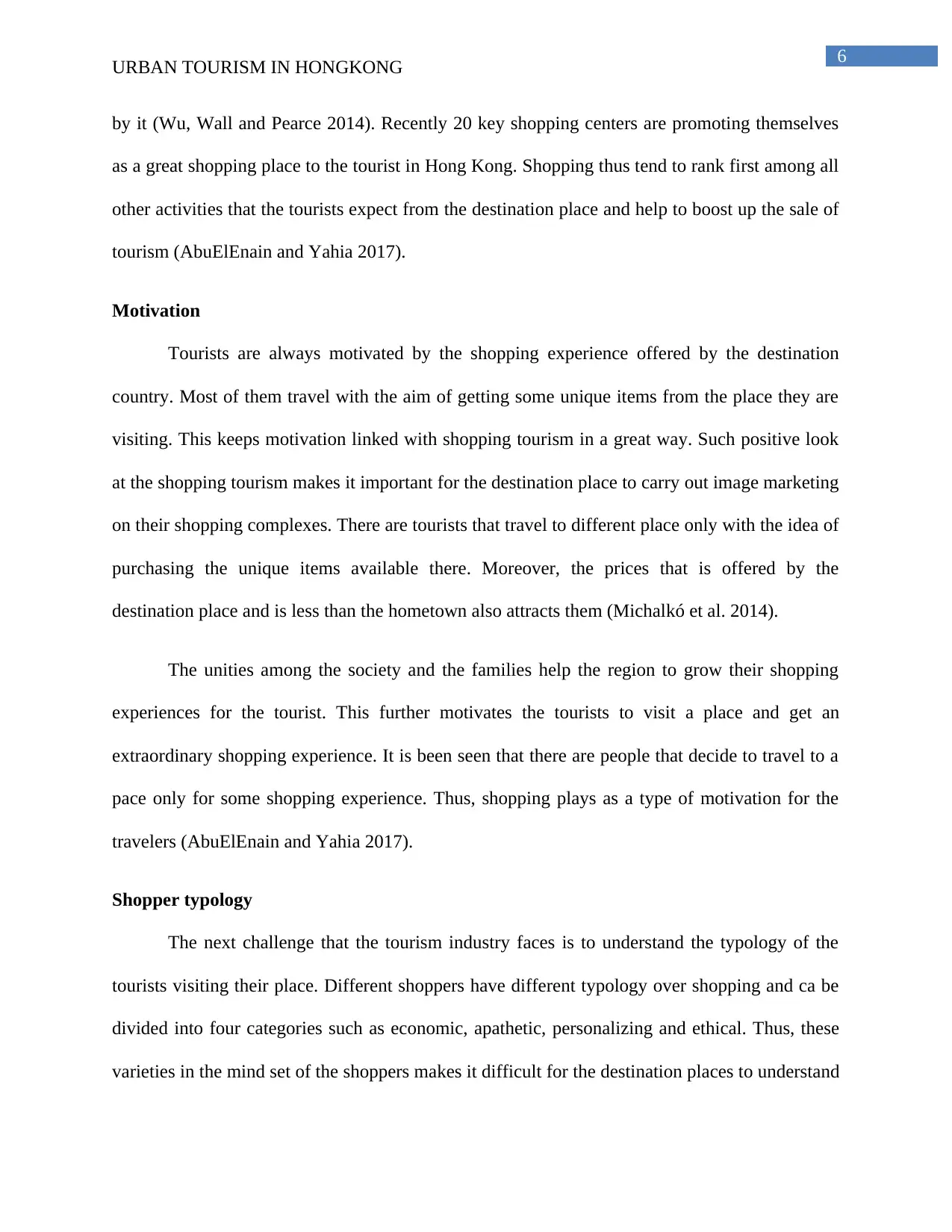
6
URBAN TOURISM IN HONGKONG
by it (Wu, Wall and Pearce 2014). Recently 20 key shopping centers are promoting themselves
as a great shopping place to the tourist in Hong Kong. Shopping thus tend to rank first among all
other activities that the tourists expect from the destination place and help to boost up the sale of
tourism (AbuElEnain and Yahia 2017).
Motivation
Tourists are always motivated by the shopping experience offered by the destination
country. Most of them travel with the aim of getting some unique items from the place they are
visiting. This keeps motivation linked with shopping tourism in a great way. Such positive look
at the shopping tourism makes it important for the destination place to carry out image marketing
on their shopping complexes. There are tourists that travel to different place only with the idea of
purchasing the unique items available there. Moreover, the prices that is offered by the
destination place and is less than the hometown also attracts them (Michalkó et al. 2014).
The unities among the society and the families help the region to grow their shopping
experiences for the tourist. This further motivates the tourists to visit a place and get an
extraordinary shopping experience. It is been seen that there are people that decide to travel to a
pace only for some shopping experience. Thus, shopping plays as a type of motivation for the
travelers (AbuElEnain and Yahia 2017).
Shopper typology
The next challenge that the tourism industry faces is to understand the typology of the
tourists visiting their place. Different shoppers have different typology over shopping and ca be
divided into four categories such as economic, apathetic, personalizing and ethical. Thus, these
varieties in the mind set of the shoppers makes it difficult for the destination places to understand
URBAN TOURISM IN HONGKONG
by it (Wu, Wall and Pearce 2014). Recently 20 key shopping centers are promoting themselves
as a great shopping place to the tourist in Hong Kong. Shopping thus tend to rank first among all
other activities that the tourists expect from the destination place and help to boost up the sale of
tourism (AbuElEnain and Yahia 2017).
Motivation
Tourists are always motivated by the shopping experience offered by the destination
country. Most of them travel with the aim of getting some unique items from the place they are
visiting. This keeps motivation linked with shopping tourism in a great way. Such positive look
at the shopping tourism makes it important for the destination place to carry out image marketing
on their shopping complexes. There are tourists that travel to different place only with the idea of
purchasing the unique items available there. Moreover, the prices that is offered by the
destination place and is less than the hometown also attracts them (Michalkó et al. 2014).
The unities among the society and the families help the region to grow their shopping
experiences for the tourist. This further motivates the tourists to visit a place and get an
extraordinary shopping experience. It is been seen that there are people that decide to travel to a
pace only for some shopping experience. Thus, shopping plays as a type of motivation for the
travelers (AbuElEnain and Yahia 2017).
Shopper typology
The next challenge that the tourism industry faces is to understand the typology of the
tourists visiting their place. Different shoppers have different typology over shopping and ca be
divided into four categories such as economic, apathetic, personalizing and ethical. Thus, these
varieties in the mind set of the shoppers makes it difficult for the destination places to understand
Paraphrase This Document
Need a fresh take? Get an instant paraphrase of this document with our AI Paraphraser
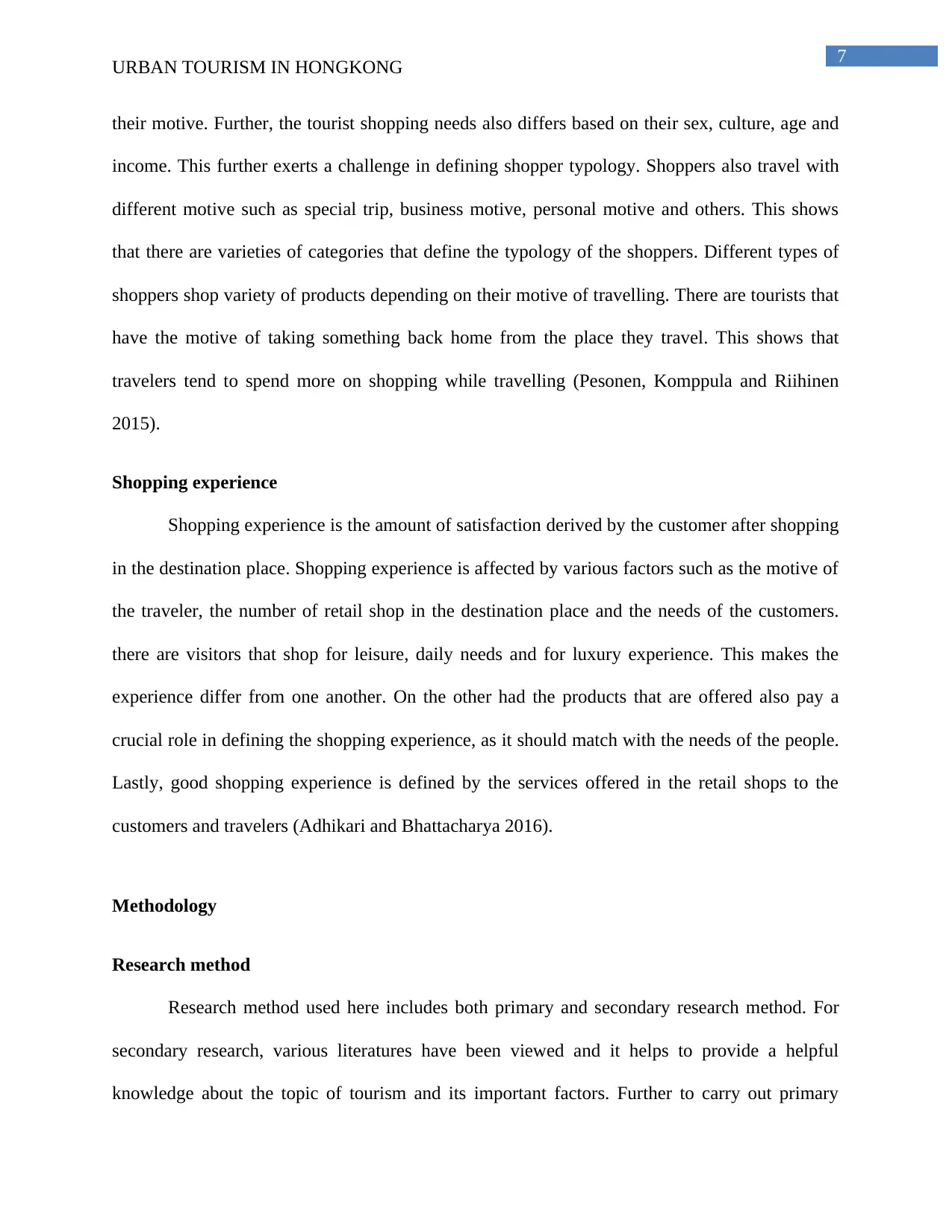
7
URBAN TOURISM IN HONGKONG
their motive. Further, the tourist shopping needs also differs based on their sex, culture, age and
income. This further exerts a challenge in defining shopper typology. Shoppers also travel with
different motive such as special trip, business motive, personal motive and others. This shows
that there are varieties of categories that define the typology of the shoppers. Different types of
shoppers shop variety of products depending on their motive of travelling. There are tourists that
have the motive of taking something back home from the place they travel. This shows that
travelers tend to spend more on shopping while travelling (Pesonen, Komppula and Riihinen
2015).
Shopping experience
Shopping experience is the amount of satisfaction derived by the customer after shopping
in the destination place. Shopping experience is affected by various factors such as the motive of
the traveler, the number of retail shop in the destination place and the needs of the customers.
there are visitors that shop for leisure, daily needs and for luxury experience. This makes the
experience differ from one another. On the other had the products that are offered also pay a
crucial role in defining the shopping experience, as it should match with the needs of the people.
Lastly, good shopping experience is defined by the services offered in the retail shops to the
customers and travelers (Adhikari and Bhattacharya 2016).
Methodology
Research method
Research method used here includes both primary and secondary research method. For
secondary research, various literatures have been viewed and it helps to provide a helpful
knowledge about the topic of tourism and its important factors. Further to carry out primary
URBAN TOURISM IN HONGKONG
their motive. Further, the tourist shopping needs also differs based on their sex, culture, age and
income. This further exerts a challenge in defining shopper typology. Shoppers also travel with
different motive such as special trip, business motive, personal motive and others. This shows
that there are varieties of categories that define the typology of the shoppers. Different types of
shoppers shop variety of products depending on their motive of travelling. There are tourists that
have the motive of taking something back home from the place they travel. This shows that
travelers tend to spend more on shopping while travelling (Pesonen, Komppula and Riihinen
2015).
Shopping experience
Shopping experience is the amount of satisfaction derived by the customer after shopping
in the destination place. Shopping experience is affected by various factors such as the motive of
the traveler, the number of retail shop in the destination place and the needs of the customers.
there are visitors that shop for leisure, daily needs and for luxury experience. This makes the
experience differ from one another. On the other had the products that are offered also pay a
crucial role in defining the shopping experience, as it should match with the needs of the people.
Lastly, good shopping experience is defined by the services offered in the retail shops to the
customers and travelers (Adhikari and Bhattacharya 2016).
Methodology
Research method
Research method used here includes both primary and secondary research method. For
secondary research, various literatures have been viewed and it helps to provide a helpful
knowledge about the topic of tourism and its important factors. Further to carry out primary
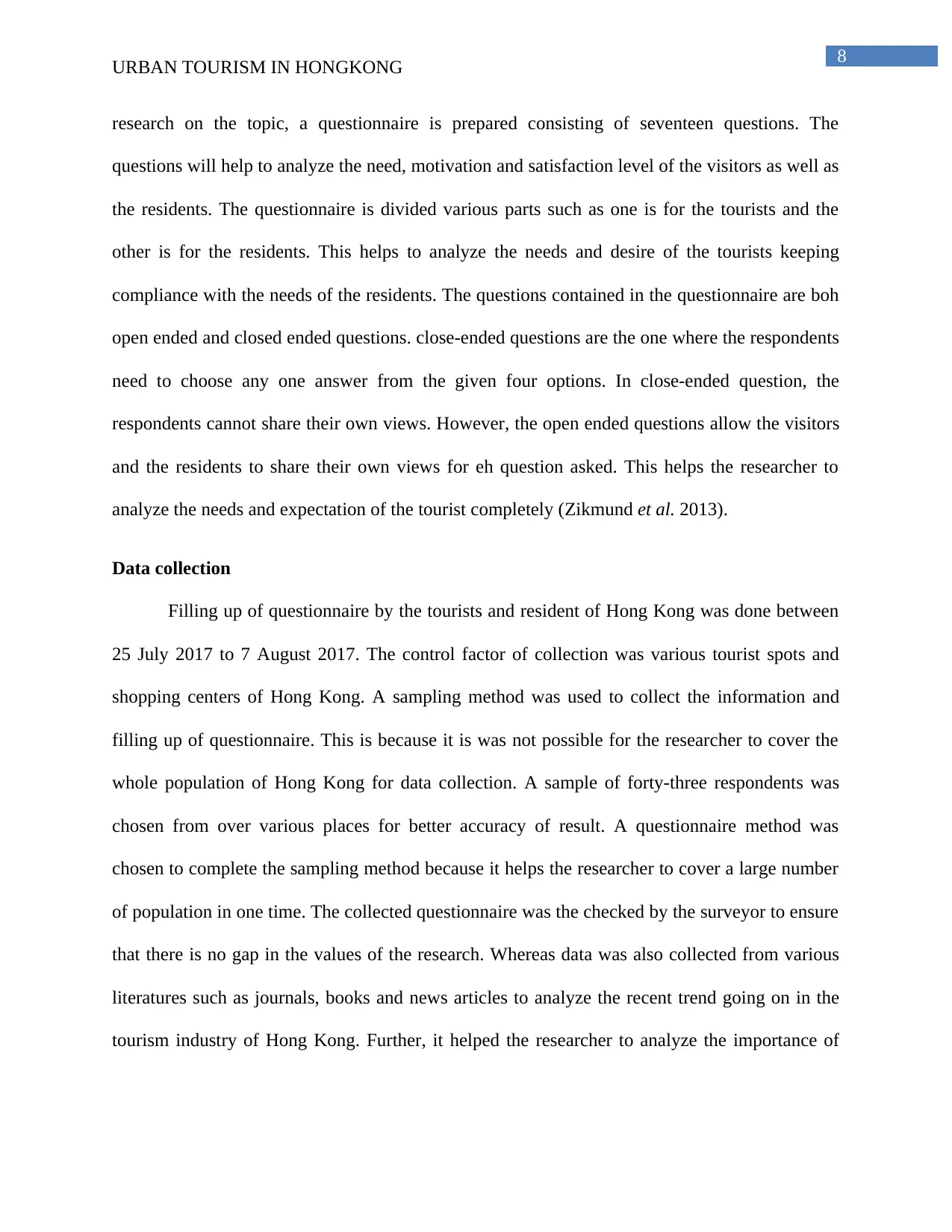
8
URBAN TOURISM IN HONGKONG
research on the topic, a questionnaire is prepared consisting of seventeen questions. The
questions will help to analyze the need, motivation and satisfaction level of the visitors as well as
the residents. The questionnaire is divided various parts such as one is for the tourists and the
other is for the residents. This helps to analyze the needs and desire of the tourists keeping
compliance with the needs of the residents. The questions contained in the questionnaire are boh
open ended and closed ended questions. close-ended questions are the one where the respondents
need to choose any one answer from the given four options. In close-ended question, the
respondents cannot share their own views. However, the open ended questions allow the visitors
and the residents to share their own views for eh question asked. This helps the researcher to
analyze the needs and expectation of the tourist completely (Zikmund et al. 2013).
Data collection
Filling up of questionnaire by the tourists and resident of Hong Kong was done between
25 July 2017 to 7 August 2017. The control factor of collection was various tourist spots and
shopping centers of Hong Kong. A sampling method was used to collect the information and
filling up of questionnaire. This is because it is was not possible for the researcher to cover the
whole population of Hong Kong for data collection. A sample of forty-three respondents was
chosen from over various places for better accuracy of result. A questionnaire method was
chosen to complete the sampling method because it helps the researcher to cover a large number
of population in one time. The collected questionnaire was the checked by the surveyor to ensure
that there is no gap in the values of the research. Whereas data was also collected from various
literatures such as journals, books and news articles to analyze the recent trend going on in the
tourism industry of Hong Kong. Further, it helped the researcher to analyze the importance of
URBAN TOURISM IN HONGKONG
research on the topic, a questionnaire is prepared consisting of seventeen questions. The
questions will help to analyze the need, motivation and satisfaction level of the visitors as well as
the residents. The questionnaire is divided various parts such as one is for the tourists and the
other is for the residents. This helps to analyze the needs and desire of the tourists keeping
compliance with the needs of the residents. The questions contained in the questionnaire are boh
open ended and closed ended questions. close-ended questions are the one where the respondents
need to choose any one answer from the given four options. In close-ended question, the
respondents cannot share their own views. However, the open ended questions allow the visitors
and the residents to share their own views for eh question asked. This helps the researcher to
analyze the needs and expectation of the tourist completely (Zikmund et al. 2013).
Data collection
Filling up of questionnaire by the tourists and resident of Hong Kong was done between
25 July 2017 to 7 August 2017. The control factor of collection was various tourist spots and
shopping centers of Hong Kong. A sampling method was used to collect the information and
filling up of questionnaire. This is because it is was not possible for the researcher to cover the
whole population of Hong Kong for data collection. A sample of forty-three respondents was
chosen from over various places for better accuracy of result. A questionnaire method was
chosen to complete the sampling method because it helps the researcher to cover a large number
of population in one time. The collected questionnaire was the checked by the surveyor to ensure
that there is no gap in the values of the research. Whereas data was also collected from various
literatures such as journals, books and news articles to analyze the recent trend going on in the
tourism industry of Hong Kong. Further, it helped the researcher to analyze the importance of
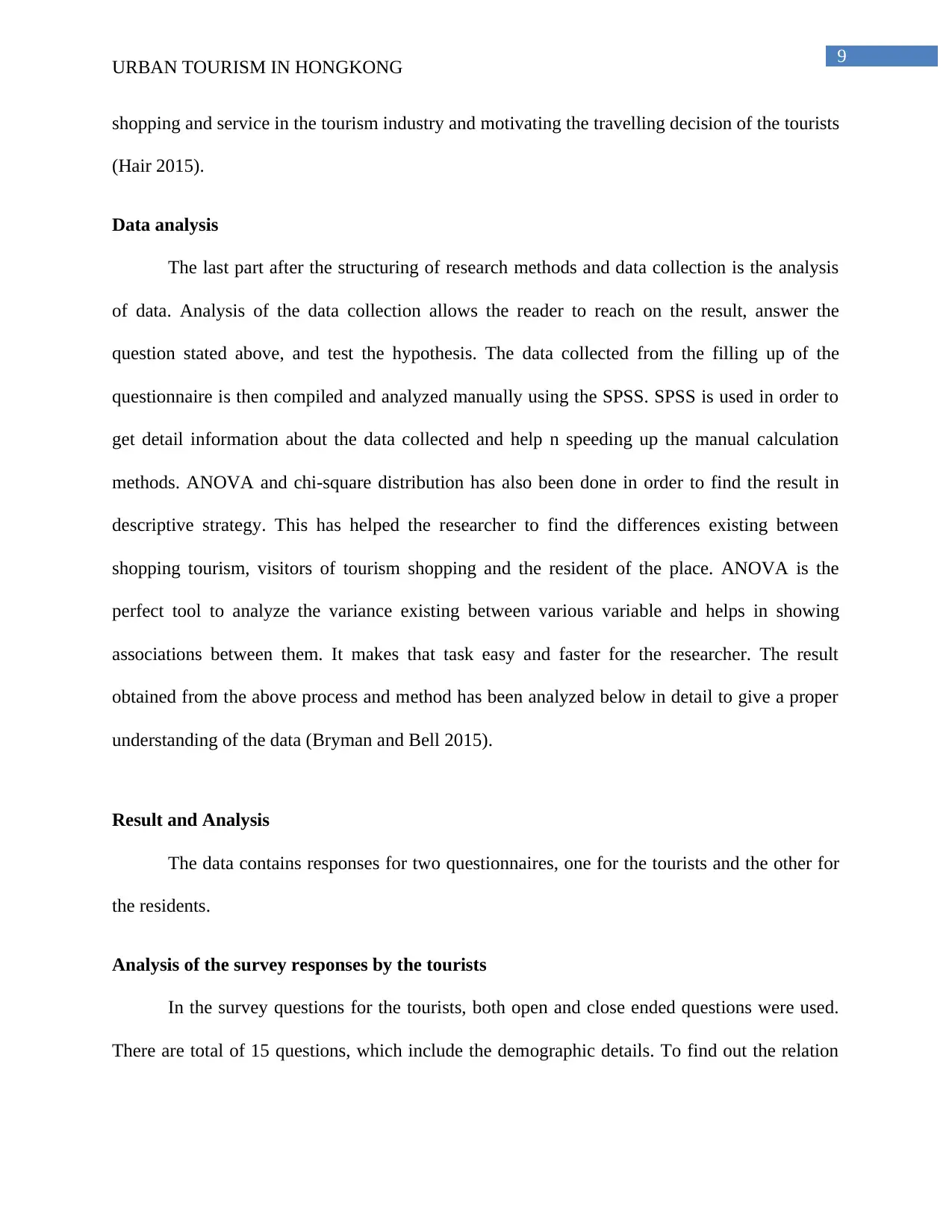
9
URBAN TOURISM IN HONGKONG
shopping and service in the tourism industry and motivating the travelling decision of the tourists
(Hair 2015).
Data analysis
The last part after the structuring of research methods and data collection is the analysis
of data. Analysis of the data collection allows the reader to reach on the result, answer the
question stated above, and test the hypothesis. The data collected from the filling up of the
questionnaire is then compiled and analyzed manually using the SPSS. SPSS is used in order to
get detail information about the data collected and help n speeding up the manual calculation
methods. ANOVA and chi-square distribution has also been done in order to find the result in
descriptive strategy. This has helped the researcher to find the differences existing between
shopping tourism, visitors of tourism shopping and the resident of the place. ANOVA is the
perfect tool to analyze the variance existing between various variable and helps in showing
associations between them. It makes that task easy and faster for the researcher. The result
obtained from the above process and method has been analyzed below in detail to give a proper
understanding of the data (Bryman and Bell 2015).
Result and Analysis
The data contains responses for two questionnaires, one for the tourists and the other for
the residents.
Analysis of the survey responses by the tourists
In the survey questions for the tourists, both open and close ended questions were used.
There are total of 15 questions, which include the demographic details. To find out the relation
URBAN TOURISM IN HONGKONG
shopping and service in the tourism industry and motivating the travelling decision of the tourists
(Hair 2015).
Data analysis
The last part after the structuring of research methods and data collection is the analysis
of data. Analysis of the data collection allows the reader to reach on the result, answer the
question stated above, and test the hypothesis. The data collected from the filling up of the
questionnaire is then compiled and analyzed manually using the SPSS. SPSS is used in order to
get detail information about the data collected and help n speeding up the manual calculation
methods. ANOVA and chi-square distribution has also been done in order to find the result in
descriptive strategy. This has helped the researcher to find the differences existing between
shopping tourism, visitors of tourism shopping and the resident of the place. ANOVA is the
perfect tool to analyze the variance existing between various variable and helps in showing
associations between them. It makes that task easy and faster for the researcher. The result
obtained from the above process and method has been analyzed below in detail to give a proper
understanding of the data (Bryman and Bell 2015).
Result and Analysis
The data contains responses for two questionnaires, one for the tourists and the other for
the residents.
Analysis of the survey responses by the tourists
In the survey questions for the tourists, both open and close ended questions were used.
There are total of 15 questions, which include the demographic details. To find out the relation
Secure Best Marks with AI Grader
Need help grading? Try our AI Grader for instant feedback on your assignments.
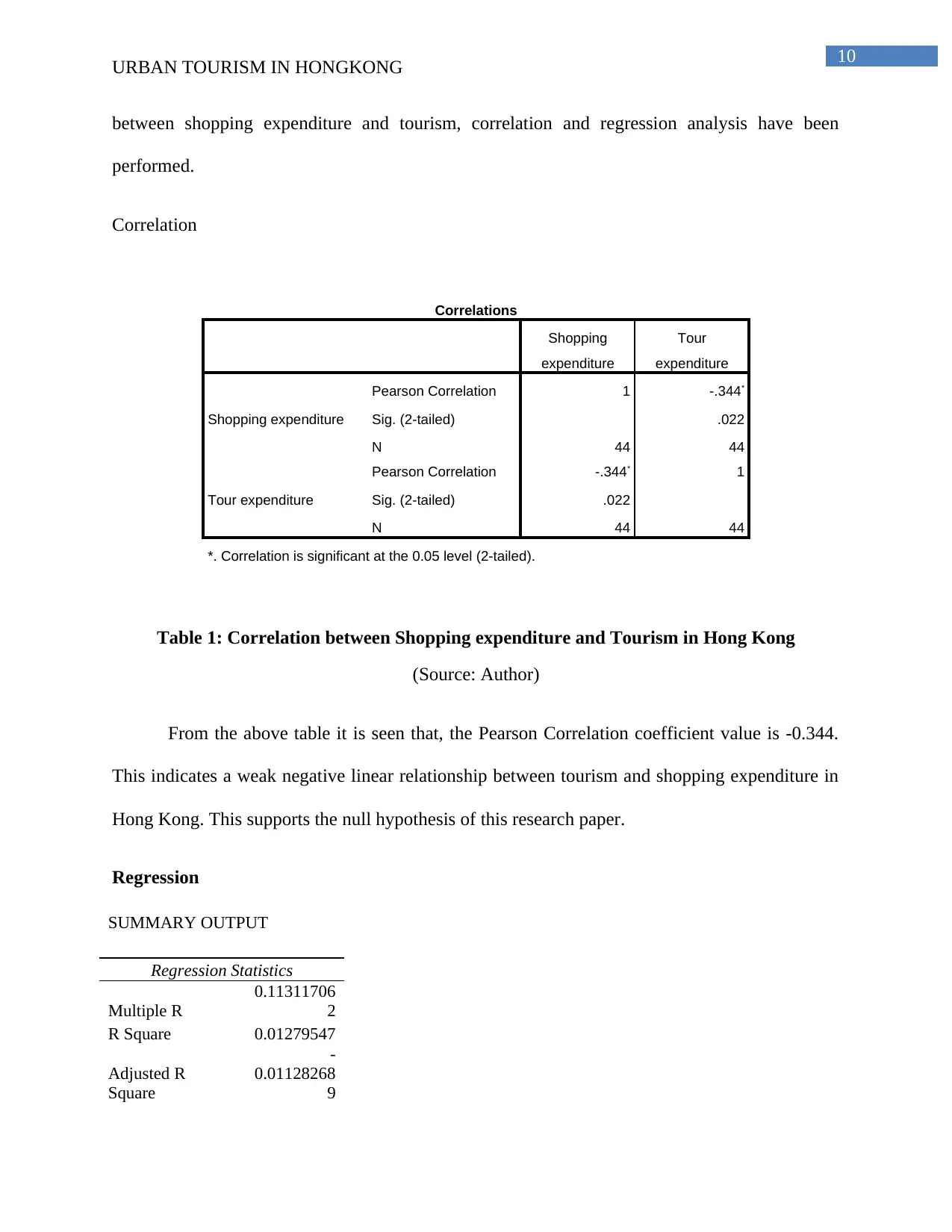
10
URBAN TOURISM IN HONGKONG
between shopping expenditure and tourism, correlation and regression analysis have been
performed.
Correlation
Correlations
Shopping
expenditure
Tour
expenditure
Shopping expenditure
Pearson Correlation 1 -.344*
Sig. (2-tailed) .022
N 44 44
Tour expenditure
Pearson Correlation -.344* 1
Sig. (2-tailed) .022
N 44 44
*. Correlation is significant at the 0.05 level (2-tailed).
Table 1: Correlation between Shopping expenditure and Tourism in Hong Kong
(Source: Author)
From the above table it is seen that, the Pearson Correlation coefficient value is -0.344.
This indicates a weak negative linear relationship between tourism and shopping expenditure in
Hong Kong. This supports the null hypothesis of this research paper.
Regression
SUMMARY OUTPUT
Regression Statistics
Multiple R
0.11311706
2
R Square 0.01279547
Adjusted R
Square
-
0.01128268
9
URBAN TOURISM IN HONGKONG
between shopping expenditure and tourism, correlation and regression analysis have been
performed.
Correlation
Correlations
Shopping
expenditure
Tour
expenditure
Shopping expenditure
Pearson Correlation 1 -.344*
Sig. (2-tailed) .022
N 44 44
Tour expenditure
Pearson Correlation -.344* 1
Sig. (2-tailed) .022
N 44 44
*. Correlation is significant at the 0.05 level (2-tailed).
Table 1: Correlation between Shopping expenditure and Tourism in Hong Kong
(Source: Author)
From the above table it is seen that, the Pearson Correlation coefficient value is -0.344.
This indicates a weak negative linear relationship between tourism and shopping expenditure in
Hong Kong. This supports the null hypothesis of this research paper.
Regression
SUMMARY OUTPUT
Regression Statistics
Multiple R
0.11311706
2
R Square 0.01279547
Adjusted R
Square
-
0.01128268
9
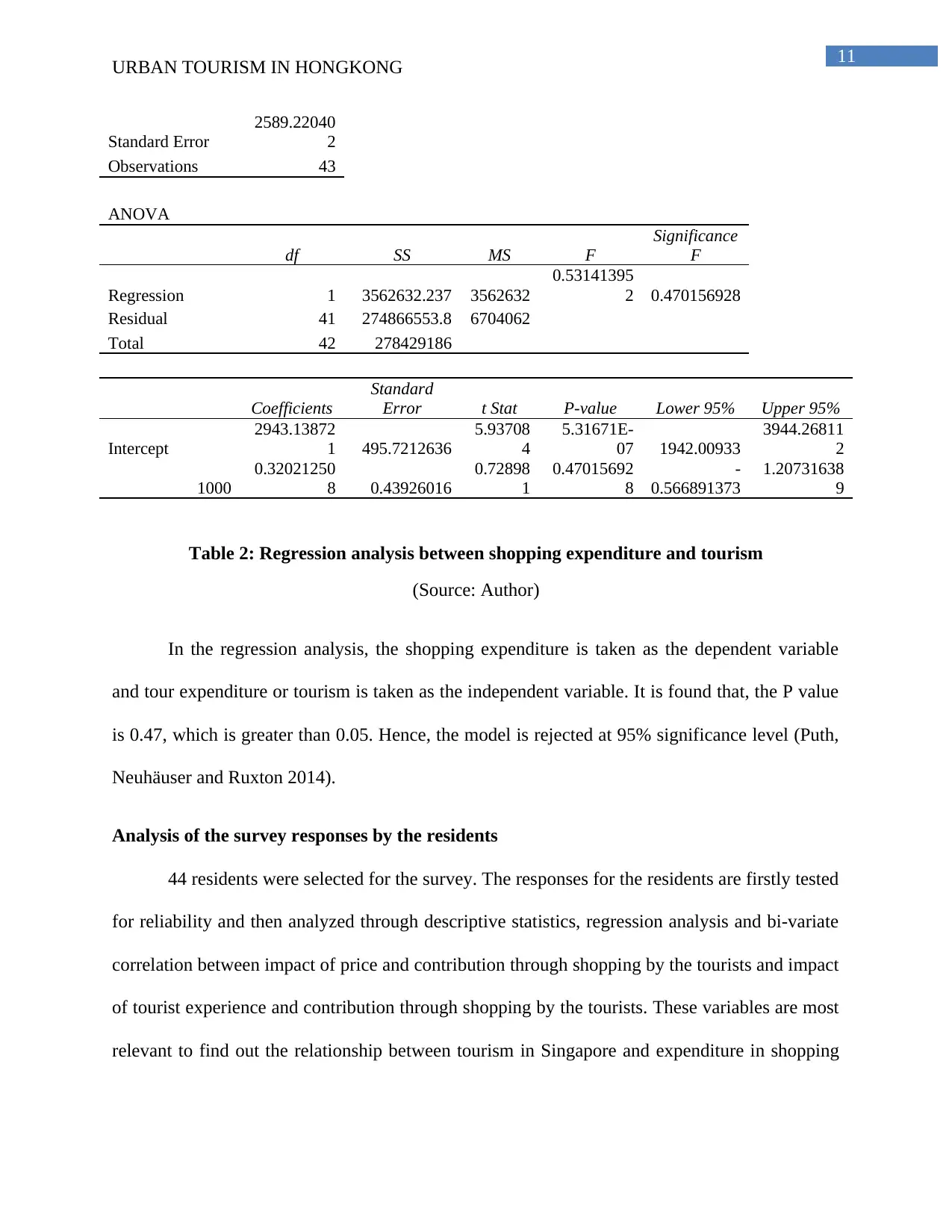
11
URBAN TOURISM IN HONGKONG
Standard Error
2589.22040
2
Observations 43
ANOVA
df SS MS F
Significance
F
Regression 1 3562632.237 3562632
0.53141395
2 0.470156928
Residual 41 274866553.8 6704062
Total 42 278429186
Coefficients
Standard
Error t Stat P-value Lower 95% Upper 95%
Intercept
2943.13872
1 495.7212636
5.93708
4
5.31671E-
07 1942.00933
3944.26811
2
1000
0.32021250
8 0.43926016
0.72898
1
0.47015692
8
-
0.566891373
1.20731638
9
Table 2: Regression analysis between shopping expenditure and tourism
(Source: Author)
In the regression analysis, the shopping expenditure is taken as the dependent variable
and tour expenditure or tourism is taken as the independent variable. It is found that, the P value
is 0.47, which is greater than 0.05. Hence, the model is rejected at 95% significance level (Puth,
Neuhäuser and Ruxton 2014).
Analysis of the survey responses by the residents
44 residents were selected for the survey. The responses for the residents are firstly tested
for reliability and then analyzed through descriptive statistics, regression analysis and bi-variate
correlation between impact of price and contribution through shopping by the tourists and impact
of tourist experience and contribution through shopping by the tourists. These variables are most
relevant to find out the relationship between tourism in Singapore and expenditure in shopping
URBAN TOURISM IN HONGKONG
Standard Error
2589.22040
2
Observations 43
ANOVA
df SS MS F
Significance
F
Regression 1 3562632.237 3562632
0.53141395
2 0.470156928
Residual 41 274866553.8 6704062
Total 42 278429186
Coefficients
Standard
Error t Stat P-value Lower 95% Upper 95%
Intercept
2943.13872
1 495.7212636
5.93708
4
5.31671E-
07 1942.00933
3944.26811
2
1000
0.32021250
8 0.43926016
0.72898
1
0.47015692
8
-
0.566891373
1.20731638
9
Table 2: Regression analysis between shopping expenditure and tourism
(Source: Author)
In the regression analysis, the shopping expenditure is taken as the dependent variable
and tour expenditure or tourism is taken as the independent variable. It is found that, the P value
is 0.47, which is greater than 0.05. Hence, the model is rejected at 95% significance level (Puth,
Neuhäuser and Ruxton 2014).
Analysis of the survey responses by the residents
44 residents were selected for the survey. The responses for the residents are firstly tested
for reliability and then analyzed through descriptive statistics, regression analysis and bi-variate
correlation between impact of price and contribution through shopping by the tourists and impact
of tourist experience and contribution through shopping by the tourists. These variables are most
relevant to find out the relationship between tourism in Singapore and expenditure in shopping
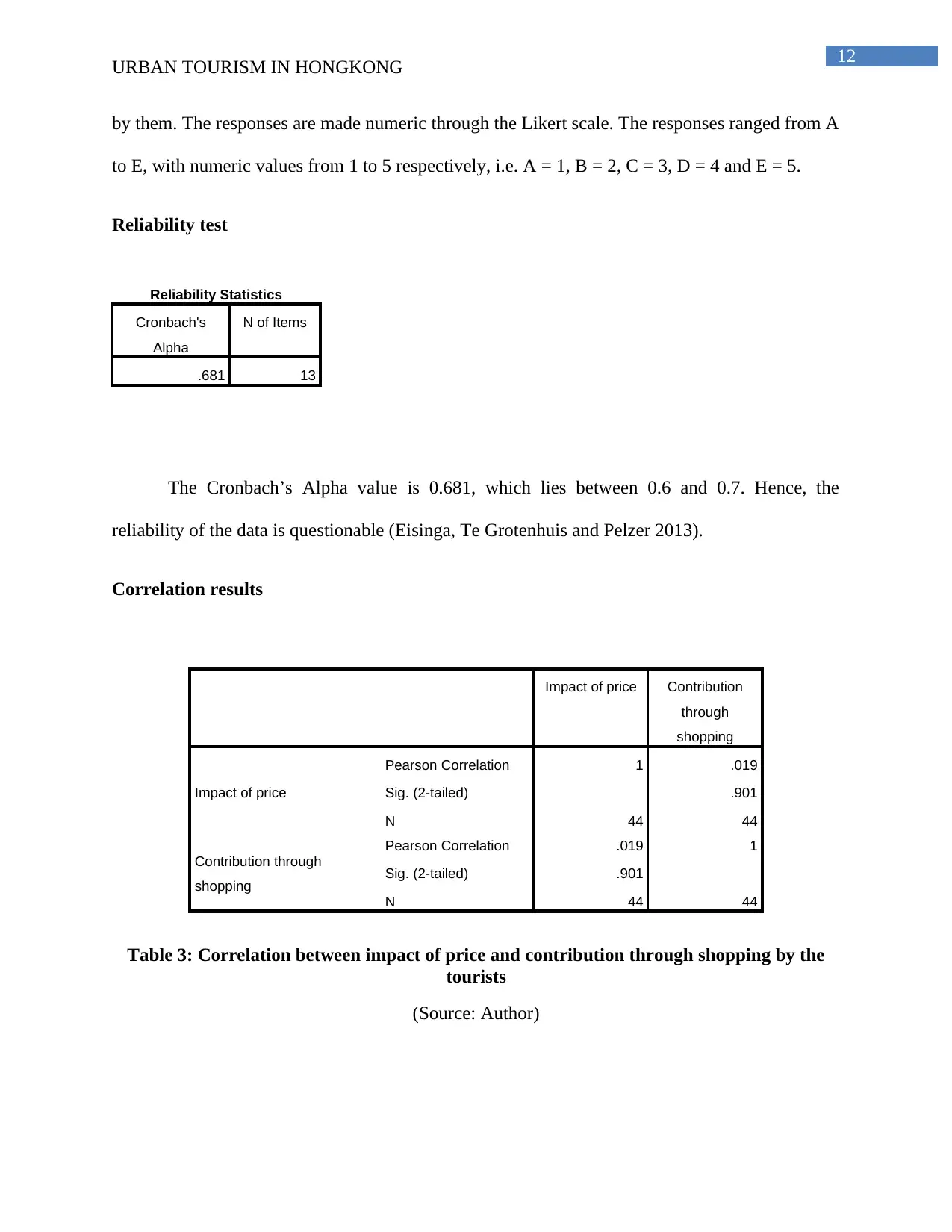
12
URBAN TOURISM IN HONGKONG
by them. The responses are made numeric through the Likert scale. The responses ranged from A
to E, with numeric values from 1 to 5 respectively, i.e. A = 1, B = 2, C = 3, D = 4 and E = 5.
Reliability test
Reliability Statistics
Cronbach's
Alpha
N of Items
.681 13
The Cronbach’s Alpha value is 0.681, which lies between 0.6 and 0.7. Hence, the
reliability of the data is questionable (Eisinga, Te Grotenhuis and Pelzer 2013).
Correlation results
Impact of price Contribution
through
shopping
Impact of price
Pearson Correlation 1 .019
Sig. (2-tailed) .901
N 44 44
Contribution through
shopping
Pearson Correlation .019 1
Sig. (2-tailed) .901
N 44 44
Table 3: Correlation between impact of price and contribution through shopping by the
tourists
(Source: Author)
URBAN TOURISM IN HONGKONG
by them. The responses are made numeric through the Likert scale. The responses ranged from A
to E, with numeric values from 1 to 5 respectively, i.e. A = 1, B = 2, C = 3, D = 4 and E = 5.
Reliability test
Reliability Statistics
Cronbach's
Alpha
N of Items
.681 13
The Cronbach’s Alpha value is 0.681, which lies between 0.6 and 0.7. Hence, the
reliability of the data is questionable (Eisinga, Te Grotenhuis and Pelzer 2013).
Correlation results
Impact of price Contribution
through
shopping
Impact of price
Pearson Correlation 1 .019
Sig. (2-tailed) .901
N 44 44
Contribution through
shopping
Pearson Correlation .019 1
Sig. (2-tailed) .901
N 44 44
Table 3: Correlation between impact of price and contribution through shopping by the
tourists
(Source: Author)
Paraphrase This Document
Need a fresh take? Get an instant paraphrase of this document with our AI Paraphraser
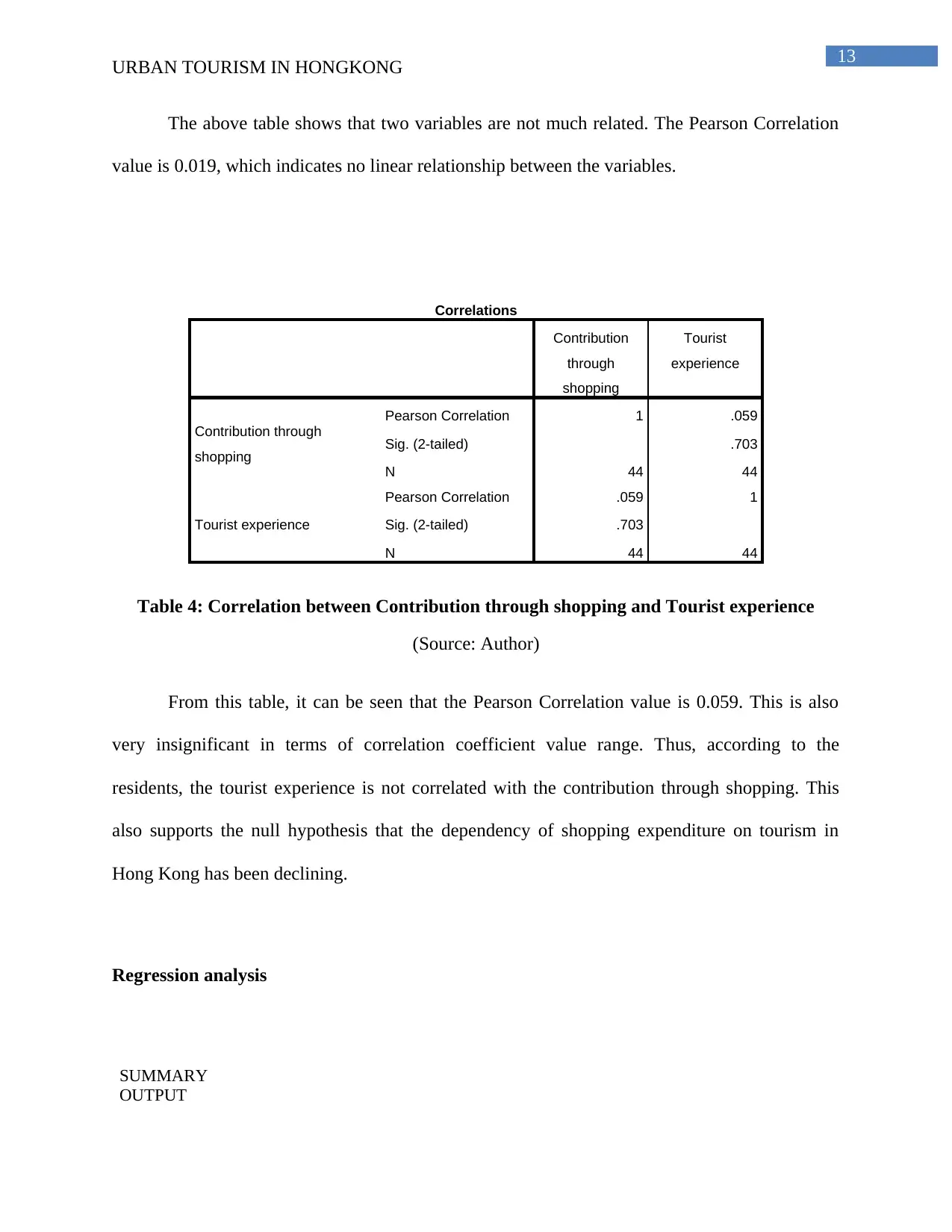
13
URBAN TOURISM IN HONGKONG
The above table shows that two variables are not much related. The Pearson Correlation
value is 0.019, which indicates no linear relationship between the variables.
Correlations
Contribution
through
shopping
Tourist
experience
Contribution through
shopping
Pearson Correlation 1 .059
Sig. (2-tailed) .703
N 44 44
Tourist experience
Pearson Correlation .059 1
Sig. (2-tailed) .703
N 44 44
Table 4: Correlation between Contribution through shopping and Tourist experience
(Source: Author)
From this table, it can be seen that the Pearson Correlation value is 0.059. This is also
very insignificant in terms of correlation coefficient value range. Thus, according to the
residents, the tourist experience is not correlated with the contribution through shopping. This
also supports the null hypothesis that the dependency of shopping expenditure on tourism in
Hong Kong has been declining.
Regression analysis
SUMMARY
OUTPUT
URBAN TOURISM IN HONGKONG
The above table shows that two variables are not much related. The Pearson Correlation
value is 0.019, which indicates no linear relationship between the variables.
Correlations
Contribution
through
shopping
Tourist
experience
Contribution through
shopping
Pearson Correlation 1 .059
Sig. (2-tailed) .703
N 44 44
Tourist experience
Pearson Correlation .059 1
Sig. (2-tailed) .703
N 44 44
Table 4: Correlation between Contribution through shopping and Tourist experience
(Source: Author)
From this table, it can be seen that the Pearson Correlation value is 0.059. This is also
very insignificant in terms of correlation coefficient value range. Thus, according to the
residents, the tourist experience is not correlated with the contribution through shopping. This
also supports the null hypothesis that the dependency of shopping expenditure on tourism in
Hong Kong has been declining.
Regression analysis
SUMMARY
OUTPUT
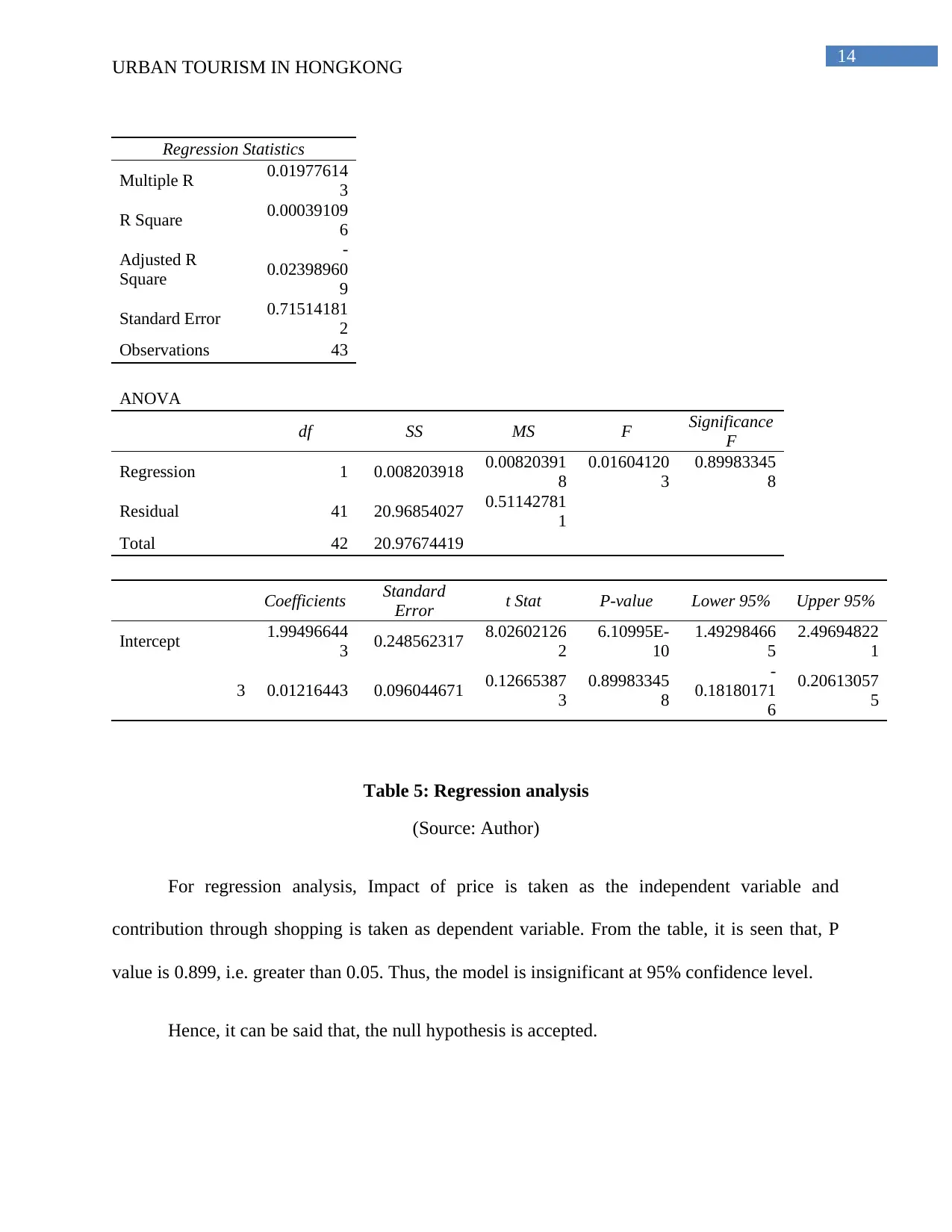
14
URBAN TOURISM IN HONGKONG
Regression Statistics
Multiple R 0.01977614
3
R Square 0.00039109
6
Adjusted R
Square
-
0.02398960
9
Standard Error 0.71514181
2
Observations 43
ANOVA
df SS MS F Significance
F
Regression 1 0.008203918 0.00820391
8
0.01604120
3
0.89983345
8
Residual 41 20.96854027 0.51142781
1
Total 42 20.97674419
Coefficients Standard
Error t Stat P-value Lower 95% Upper 95%
Intercept 1.99496644
3 0.248562317 8.02602126
2
6.10995E-
10
1.49298466
5
2.49694822
1
3 0.01216443 0.096044671 0.12665387
3
0.89983345
8
-
0.18180171
6
0.20613057
5
Table 5: Regression analysis
(Source: Author)
For regression analysis, Impact of price is taken as the independent variable and
contribution through shopping is taken as dependent variable. From the table, it is seen that, P
value is 0.899, i.e. greater than 0.05. Thus, the model is insignificant at 95% confidence level.
Hence, it can be said that, the null hypothesis is accepted.
URBAN TOURISM IN HONGKONG
Regression Statistics
Multiple R 0.01977614
3
R Square 0.00039109
6
Adjusted R
Square
-
0.02398960
9
Standard Error 0.71514181
2
Observations 43
ANOVA
df SS MS F Significance
F
Regression 1 0.008203918 0.00820391
8
0.01604120
3
0.89983345
8
Residual 41 20.96854027 0.51142781
1
Total 42 20.97674419
Coefficients Standard
Error t Stat P-value Lower 95% Upper 95%
Intercept 1.99496644
3 0.248562317 8.02602126
2
6.10995E-
10
1.49298466
5
2.49694822
1
3 0.01216443 0.096044671 0.12665387
3
0.89983345
8
-
0.18180171
6
0.20613057
5
Table 5: Regression analysis
(Source: Author)
For regression analysis, Impact of price is taken as the independent variable and
contribution through shopping is taken as dependent variable. From the table, it is seen that, P
value is 0.899, i.e. greater than 0.05. Thus, the model is insignificant at 95% confidence level.
Hence, it can be said that, the null hypothesis is accepted.
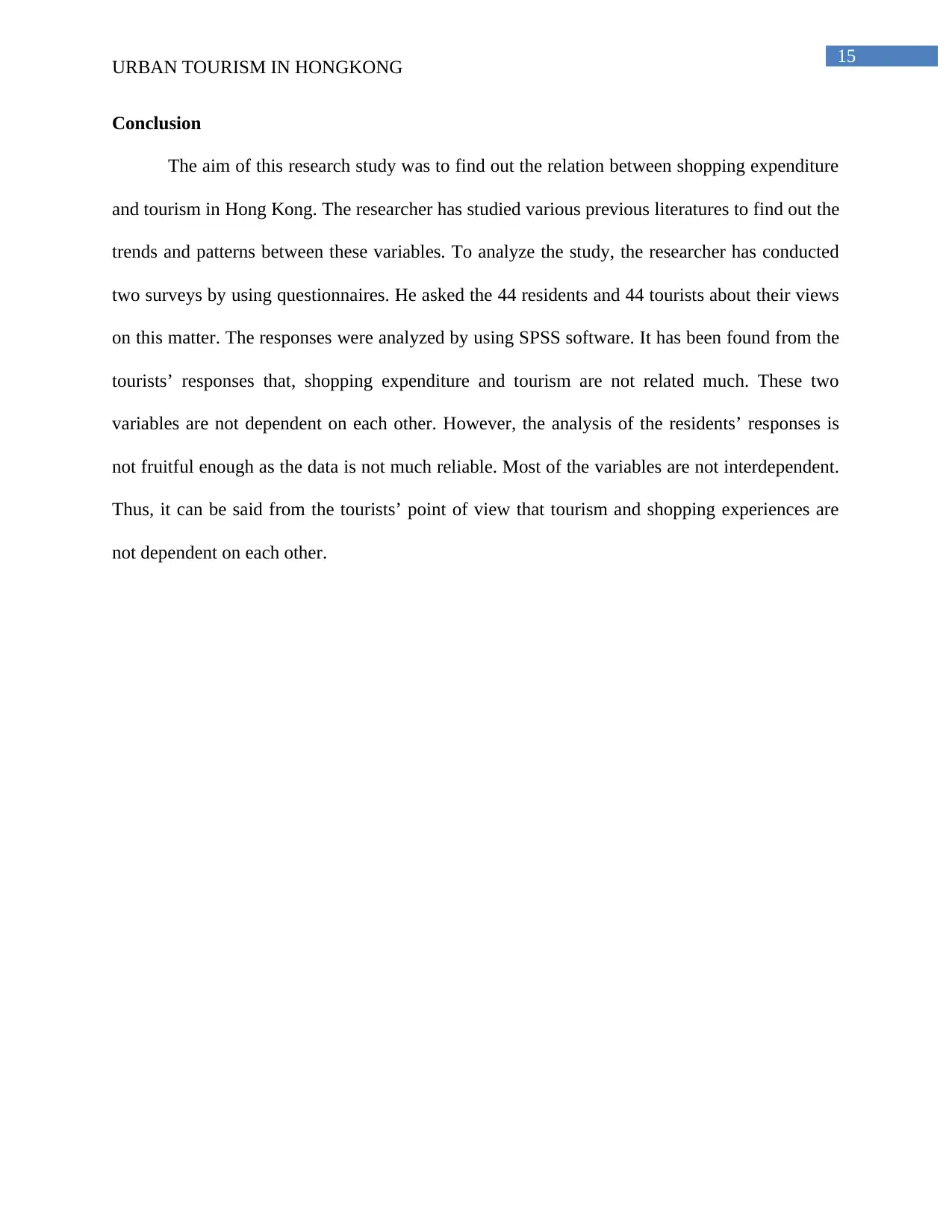
15
URBAN TOURISM IN HONGKONG
Conclusion
The aim of this research study was to find out the relation between shopping expenditure
and tourism in Hong Kong. The researcher has studied various previous literatures to find out the
trends and patterns between these variables. To analyze the study, the researcher has conducted
two surveys by using questionnaires. He asked the 44 residents and 44 tourists about their views
on this matter. The responses were analyzed by using SPSS software. It has been found from the
tourists’ responses that, shopping expenditure and tourism are not related much. These two
variables are not dependent on each other. However, the analysis of the residents’ responses is
not fruitful enough as the data is not much reliable. Most of the variables are not interdependent.
Thus, it can be said from the tourists’ point of view that tourism and shopping experiences are
not dependent on each other.
URBAN TOURISM IN HONGKONG
Conclusion
The aim of this research study was to find out the relation between shopping expenditure
and tourism in Hong Kong. The researcher has studied various previous literatures to find out the
trends and patterns between these variables. To analyze the study, the researcher has conducted
two surveys by using questionnaires. He asked the 44 residents and 44 tourists about their views
on this matter. The responses were analyzed by using SPSS software. It has been found from the
tourists’ responses that, shopping expenditure and tourism are not related much. These two
variables are not dependent on each other. However, the analysis of the residents’ responses is
not fruitful enough as the data is not much reliable. Most of the variables are not interdependent.
Thus, it can be said from the tourists’ point of view that tourism and shopping experiences are
not dependent on each other.
Secure Best Marks with AI Grader
Need help grading? Try our AI Grader for instant feedback on your assignments.
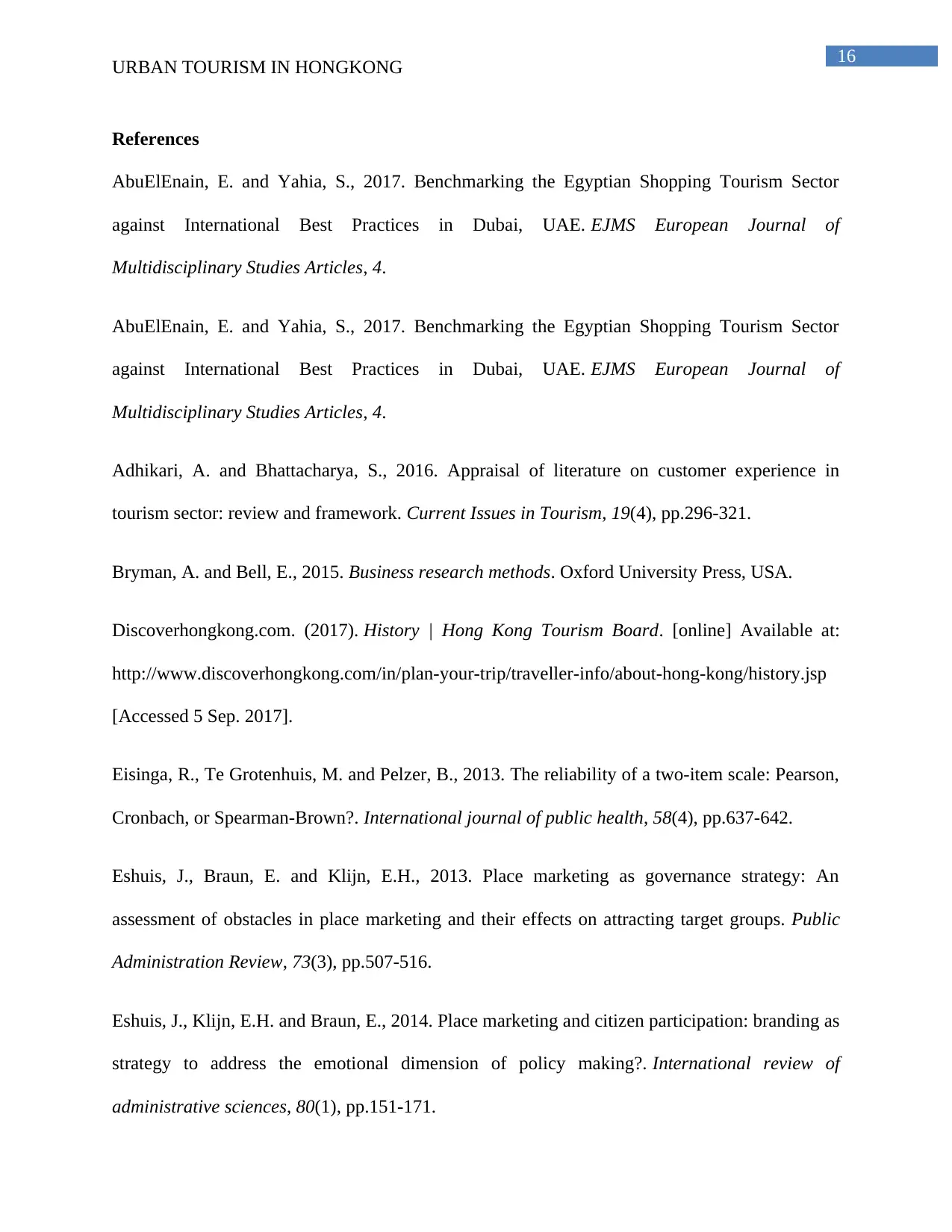
16
URBAN TOURISM IN HONGKONG
References
AbuElEnain, E. and Yahia, S., 2017. Benchmarking the Egyptian Shopping Tourism Sector
against International Best Practices in Dubai, UAE. EJMS European Journal of
Multidisciplinary Studies Articles, 4.
AbuElEnain, E. and Yahia, S., 2017. Benchmarking the Egyptian Shopping Tourism Sector
against International Best Practices in Dubai, UAE. EJMS European Journal of
Multidisciplinary Studies Articles, 4.
Adhikari, A. and Bhattacharya, S., 2016. Appraisal of literature on customer experience in
tourism sector: review and framework. Current Issues in Tourism, 19(4), pp.296-321.
Bryman, A. and Bell, E., 2015. Business research methods. Oxford University Press, USA.
Discoverhongkong.com. (2017). History | Hong Kong Tourism Board. [online] Available at:
http://www.discoverhongkong.com/in/plan-your-trip/traveller-info/about-hong-kong/history.jsp
[Accessed 5 Sep. 2017].
Eisinga, R., Te Grotenhuis, M. and Pelzer, B., 2013. The reliability of a two-item scale: Pearson,
Cronbach, or Spearman-Brown?. International journal of public health, 58(4), pp.637-642.
Eshuis, J., Braun, E. and Klijn, E.H., 2013. Place marketing as governance strategy: An
assessment of obstacles in place marketing and their effects on attracting target groups. Public
Administration Review, 73(3), pp.507-516.
Eshuis, J., Klijn, E.H. and Braun, E., 2014. Place marketing and citizen participation: branding as
strategy to address the emotional dimension of policy making?. International review of
administrative sciences, 80(1), pp.151-171.
URBAN TOURISM IN HONGKONG
References
AbuElEnain, E. and Yahia, S., 2017. Benchmarking the Egyptian Shopping Tourism Sector
against International Best Practices in Dubai, UAE. EJMS European Journal of
Multidisciplinary Studies Articles, 4.
AbuElEnain, E. and Yahia, S., 2017. Benchmarking the Egyptian Shopping Tourism Sector
against International Best Practices in Dubai, UAE. EJMS European Journal of
Multidisciplinary Studies Articles, 4.
Adhikari, A. and Bhattacharya, S., 2016. Appraisal of literature on customer experience in
tourism sector: review and framework. Current Issues in Tourism, 19(4), pp.296-321.
Bryman, A. and Bell, E., 2015. Business research methods. Oxford University Press, USA.
Discoverhongkong.com. (2017). History | Hong Kong Tourism Board. [online] Available at:
http://www.discoverhongkong.com/in/plan-your-trip/traveller-info/about-hong-kong/history.jsp
[Accessed 5 Sep. 2017].
Eisinga, R., Te Grotenhuis, M. and Pelzer, B., 2013. The reliability of a two-item scale: Pearson,
Cronbach, or Spearman-Brown?. International journal of public health, 58(4), pp.637-642.
Eshuis, J., Braun, E. and Klijn, E.H., 2013. Place marketing as governance strategy: An
assessment of obstacles in place marketing and their effects on attracting target groups. Public
Administration Review, 73(3), pp.507-516.
Eshuis, J., Klijn, E.H. and Braun, E., 2014. Place marketing and citizen participation: branding as
strategy to address the emotional dimension of policy making?. International review of
administrative sciences, 80(1), pp.151-171.
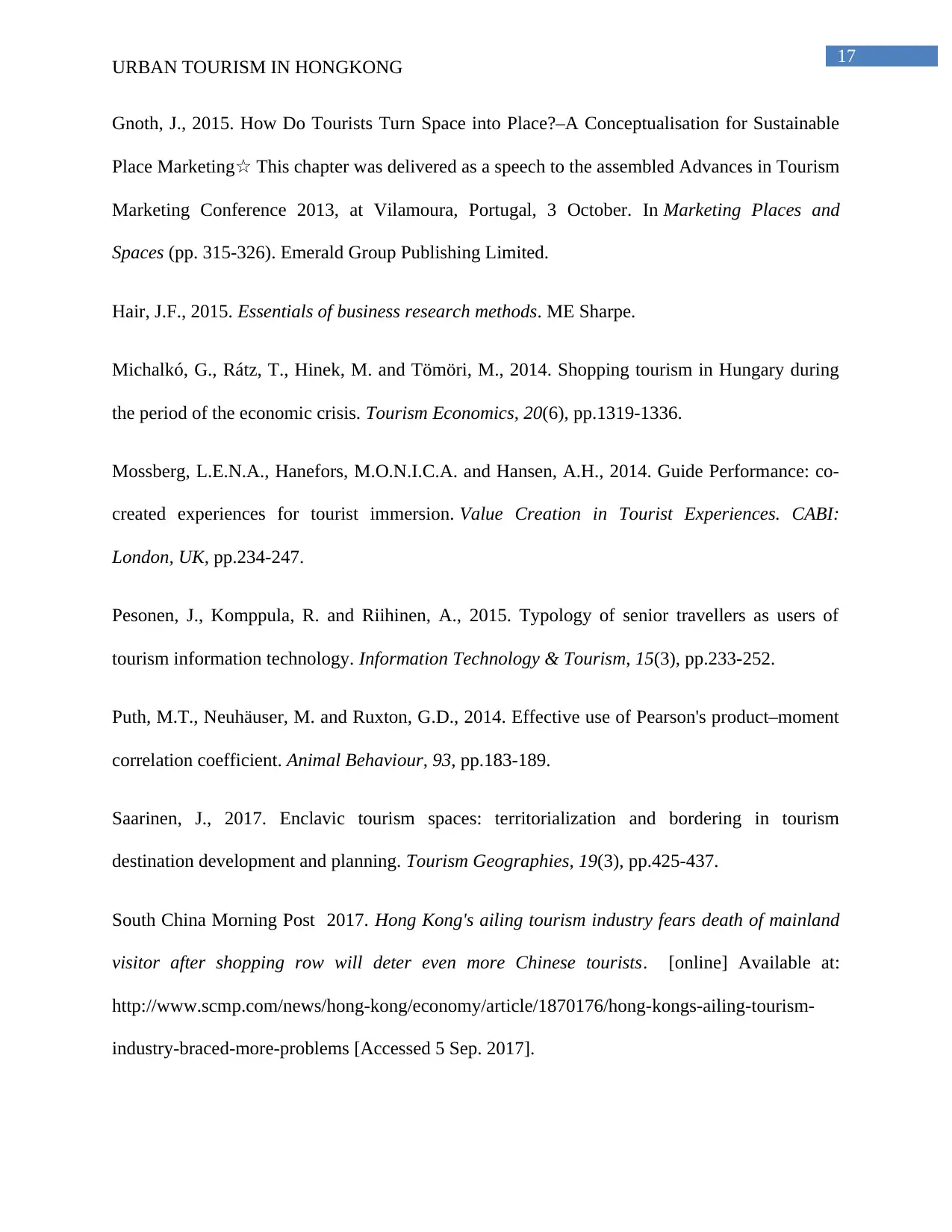
17
URBAN TOURISM IN HONGKONG
Gnoth, J., 2015. How Do Tourists Turn Space into Place?–A Conceptualisation for Sustainable
Place Marketing☆ This chapter was delivered as a speech to the assembled Advances in Tourism
Marketing Conference 2013, at Vilamoura, Portugal, 3 October. In Marketing Places and
Spaces (pp. 315-326). Emerald Group Publishing Limited.
Hair, J.F., 2015. Essentials of business research methods. ME Sharpe.
Michalkó, G., Rátz, T., Hinek, M. and Tömöri, M., 2014. Shopping tourism in Hungary during
the period of the economic crisis. Tourism Economics, 20(6), pp.1319-1336.
Mossberg, L.E.N.A., Hanefors, M.O.N.I.C.A. and Hansen, A.H., 2014. Guide Performance: co-
created experiences for tourist immersion. Value Creation in Tourist Experiences. CABI:
London, UK, pp.234-247.
Pesonen, J., Komppula, R. and Riihinen, A., 2015. Typology of senior travellers as users of
tourism information technology. Information Technology & Tourism, 15(3), pp.233-252.
Puth, M.T., Neuhäuser, M. and Ruxton, G.D., 2014. Effective use of Pearson's product–moment
correlation coefficient. Animal Behaviour, 93, pp.183-189.
Saarinen, J., 2017. Enclavic tourism spaces: territorialization and bordering in tourism
destination development and planning. Tourism Geographies, 19(3), pp.425-437.
South China Morning Post 2017. Hong Kong's ailing tourism industry fears death of mainland
visitor after shopping row will deter even more Chinese tourists. [online] Available at:
http://www.scmp.com/news/hong-kong/economy/article/1870176/hong-kongs-ailing-tourism-
industry-braced-more-problems [Accessed 5 Sep. 2017].
URBAN TOURISM IN HONGKONG
Gnoth, J., 2015. How Do Tourists Turn Space into Place?–A Conceptualisation for Sustainable
Place Marketing☆ This chapter was delivered as a speech to the assembled Advances in Tourism
Marketing Conference 2013, at Vilamoura, Portugal, 3 October. In Marketing Places and
Spaces (pp. 315-326). Emerald Group Publishing Limited.
Hair, J.F., 2015. Essentials of business research methods. ME Sharpe.
Michalkó, G., Rátz, T., Hinek, M. and Tömöri, M., 2014. Shopping tourism in Hungary during
the period of the economic crisis. Tourism Economics, 20(6), pp.1319-1336.
Mossberg, L.E.N.A., Hanefors, M.O.N.I.C.A. and Hansen, A.H., 2014. Guide Performance: co-
created experiences for tourist immersion. Value Creation in Tourist Experiences. CABI:
London, UK, pp.234-247.
Pesonen, J., Komppula, R. and Riihinen, A., 2015. Typology of senior travellers as users of
tourism information technology. Information Technology & Tourism, 15(3), pp.233-252.
Puth, M.T., Neuhäuser, M. and Ruxton, G.D., 2014. Effective use of Pearson's product–moment
correlation coefficient. Animal Behaviour, 93, pp.183-189.
Saarinen, J., 2017. Enclavic tourism spaces: territorialization and bordering in tourism
destination development and planning. Tourism Geographies, 19(3), pp.425-437.
South China Morning Post 2017. Hong Kong's ailing tourism industry fears death of mainland
visitor after shopping row will deter even more Chinese tourists. [online] Available at:
http://www.scmp.com/news/hong-kong/economy/article/1870176/hong-kongs-ailing-tourism-
industry-braced-more-problems [Accessed 5 Sep. 2017].
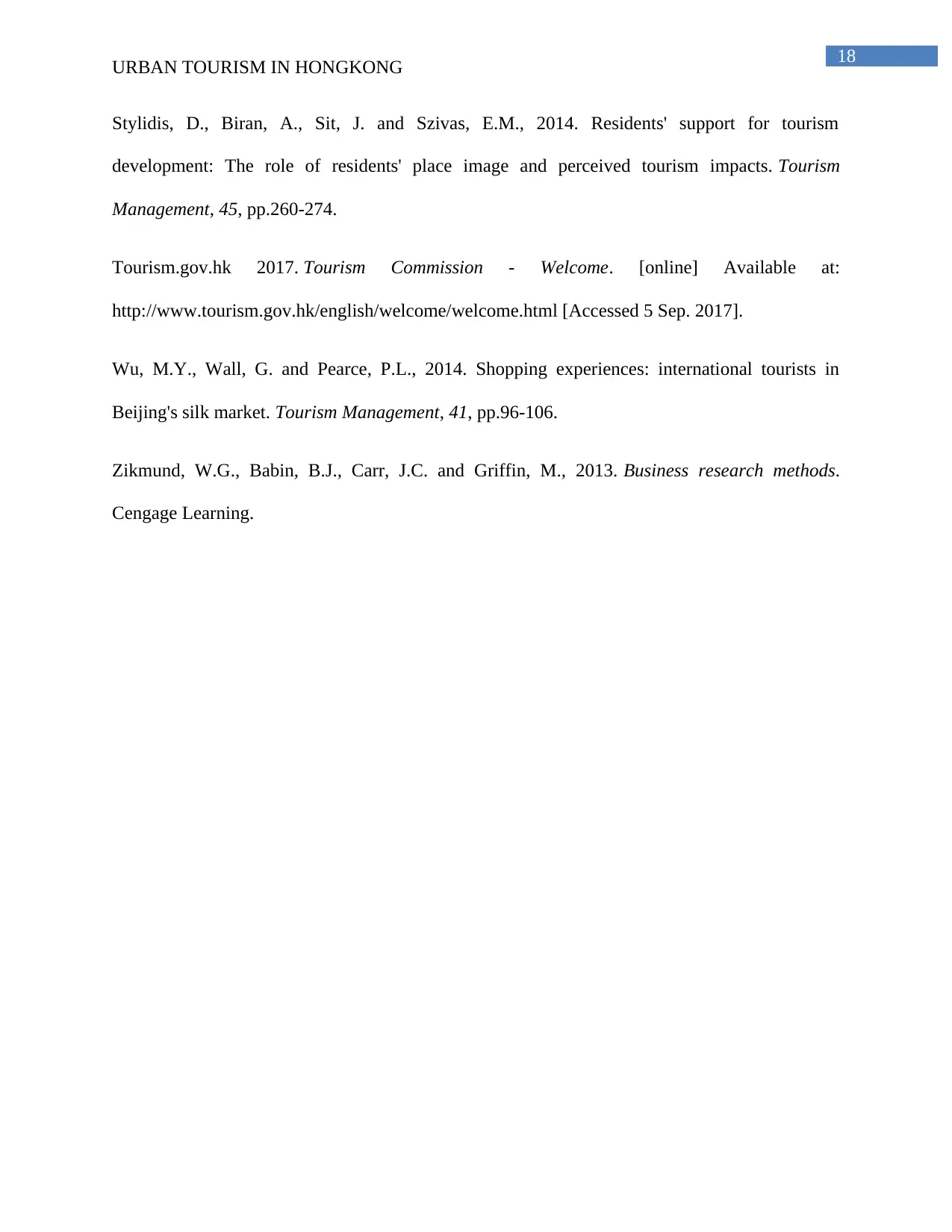
18
URBAN TOURISM IN HONGKONG
Stylidis, D., Biran, A., Sit, J. and Szivas, E.M., 2014. Residents' support for tourism
development: The role of residents' place image and perceived tourism impacts. Tourism
Management, 45, pp.260-274.
Tourism.gov.hk 2017. Tourism Commission - Welcome. [online] Available at:
http://www.tourism.gov.hk/english/welcome/welcome.html [Accessed 5 Sep. 2017].
Wu, M.Y., Wall, G. and Pearce, P.L., 2014. Shopping experiences: international tourists in
Beijing's silk market. Tourism Management, 41, pp.96-106.
Zikmund, W.G., Babin, B.J., Carr, J.C. and Griffin, M., 2013. Business research methods.
Cengage Learning.
URBAN TOURISM IN HONGKONG
Stylidis, D., Biran, A., Sit, J. and Szivas, E.M., 2014. Residents' support for tourism
development: The role of residents' place image and perceived tourism impacts. Tourism
Management, 45, pp.260-274.
Tourism.gov.hk 2017. Tourism Commission - Welcome. [online] Available at:
http://www.tourism.gov.hk/english/welcome/welcome.html [Accessed 5 Sep. 2017].
Wu, M.Y., Wall, G. and Pearce, P.L., 2014. Shopping experiences: international tourists in
Beijing's silk market. Tourism Management, 41, pp.96-106.
Zikmund, W.G., Babin, B.J., Carr, J.C. and Griffin, M., 2013. Business research methods.
Cengage Learning.
1 out of 19
Related Documents
Your All-in-One AI-Powered Toolkit for Academic Success.
+13062052269
info@desklib.com
Available 24*7 on WhatsApp / Email
![[object Object]](/_next/static/media/star-bottom.7253800d.svg)
Unlock your academic potential
© 2024 | Zucol Services PVT LTD | All rights reserved.





